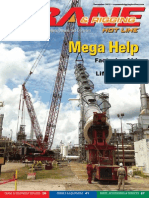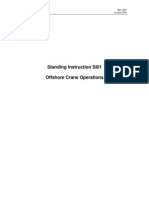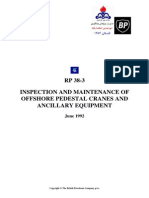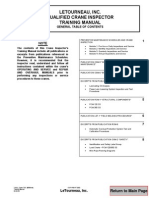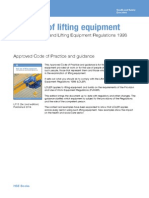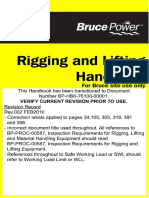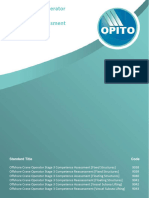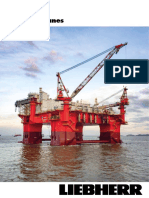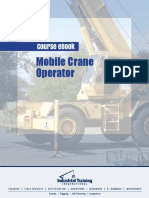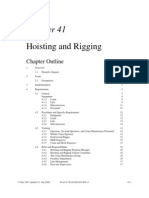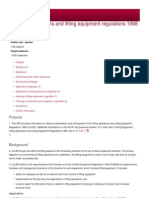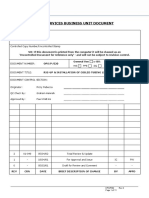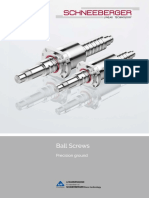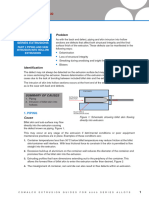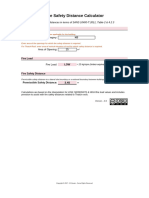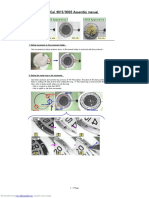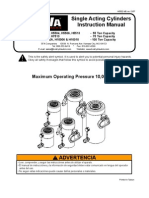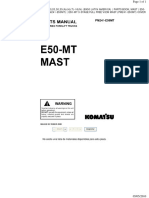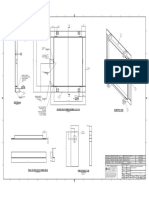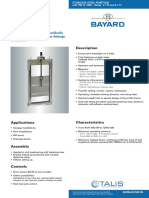Sparrows Crane Offshore Crane Operator and Banksman Integrated Safe Operating Procedures
Sparrows Crane Offshore Crane Operator and Banksman Integrated Safe Operating Procedures
Uploaded by
Trần T Như QuyênCopyright:
Available Formats
Sparrows Crane Offshore Crane Operator and Banksman Integrated Safe Operating Procedures
Sparrows Crane Offshore Crane Operator and Banksman Integrated Safe Operating Procedures
Uploaded by
Trần T Như QuyênCopyright
Available Formats
Share this document
Did you find this document useful?
Is this content inappropriate?
Copyright:
Available Formats
Sparrows Crane Offshore Crane Operator and Banksman Integrated Safe Operating Procedures
Sparrows Crane Offshore Crane Operator and Banksman Integrated Safe Operating Procedures
Uploaded by
Trần T Như QuyênCopyright:
Available Formats
Offshore Crane Operator and Banksman/Slinger Integrated Safe Operating Procedures
Doc. No. SI01_R03A4
Copyright Sparrows Offshore
INDEX 1.0 2.0 3.0 4.0 5.0 REVISION STATUS AND APPROVAL INTRODUCTION ARRIVAL OFFSHORE COMPETENT PERSON - CRANE OPERATIONS LIFTING OPERATIONS AND LIFTING EQUIPMENT REGULATIONS SI 1998 / 2307 5.1 5.2 5.3 5.4 5.5 5.6 5.7 5.8 5.9 5.10 5.11 5.12 5.13 6.0 Introduction Citation and Commencement Interpretation Application Strength and stability Lifting Equipment for Lifting Persons Positioning and Installation Marking of Lifting Equipment Organisation of Lifting Operations Thorough Examination and Inspection Planning a Lifting Operation Flowchart Lifting Operations Categories Flowchart Lifting Operation Plan Template
CRANE DAILY CHECKS AND INSPECTIONS 6.1 6.2 6.3 6.4 6.5 6.6 6.7 6.8 6.9 6.10 6.11 Crane Access ladders, Walkways and hatches Pre-start checks Housekeeping Start-up (prime mover) Overhoist Limits/cut-outs Rated Capacity Indicators Emergency Load Release And Gross Overload Protection System Emergency Engine Stops Safety Equipment Refuelling the Crane Checks to be Carried out during Operation of the Crane
7.0
GENERAL CRANE OPERATIONS 7.1 7.2 7.3 7.4 7.5 7.6 7.7 Signals Load Handling/Movement on the Installation Cargo Handling - Supply Vessels Crane Operation - FPSOs Bulk Hose Handling Operations Personnel Carrier Transfers Helicopter / Crane Operations
8.0
GENERAL INSTRUCTIONS 7.1 7.2 Do Nots DOs
9.0
Banksmen / Slingers 8.1 8.2 8.3 Introduction The Banksman / Slinger Safe Working Procedures
10.0 11.0 12.0 13.0 14.0 15.0 16.0 17.0 18.0 19.0
RECOMMENDED CRANE SIGNALS - BS7121 CONTROLLING CRANE OPERATIONS BY TWO WAY RADIO COMMUNICATION ADVERSE WEATHER GUIDELINES WIRE ROPES - CARE AND INSPECTION SAFE USE OF LIFTING ACCESSORIES EFFECTS OF DYNAMIC LOADING EYEBOLTS ESTIMATION OF WEIGHT TABLES REFERENCES
Offshore Crane Operator & Banksman/Slinger Integrated Safe Operating Procedures
SI01_R03A4 June 2001
1.0 Revision Status and Approval
Date Aug 1998 Jan 2000 Aug 2001 Revision 1 2 3 Changes made First controlled issue Amend to meet basic LOLER requirements Add further information on lifting plans as required by LOLER and add lessons learned since last issue Approved by K M Scott K M Scott
Offshore Crane Operator & Banksman/Slinger Integrated Safe Operating Procedures
SI01_R03A4 June 2001
2.0
Introduction
2.1 The purpose of this Manual is to provide Offshore Crane Operators and associated personnel with fundamental safe working procedures applicable to offshore crane operations. 2.2 These procedures can be applied in respect of crane operations, regardless of type, classification or location offshore. 2.3 They should be used in conjunction with and complement, relevant sections of the individual installations own Safe Operating Procedures, with any applicable Standing Instructions or Orders allied to crane operations and with BS 7121-Safe Use of Cranes. Where applicable, relevant sections of the UKOOA Guidelines for the Safe Packing and Handling of Cargo to and From Offshore Locations shall be complied with. 2.4 S.I.2307 - The Lifting Operations and Lifting Equipment Regulations 1998,
(LOLER) which covers all aspects of lifting operations shall be applied. Additionally appropriate reference should be made to other statutory instruments upon which LOLER builds. They are:(i) (ii) S.I.2306 - The Provision and Use of Work Equipment Regulations 1998 (PUWER) S.I.2051 - The Management of Health and Safety at Work Regulations 1999 (MHSWR).
It is essential that reference be made to these regulations when planning any lifting operations or procuring lifting equipment (Ref. 5.1 to 5.13). 2.5 Where applicable the requirements of the Control of Substances Hazardous to Health Regulations 1999 and The Manual Handling Operations Regulations 1992 shall be implemented at the worksite in the form of suitable and sufficient assessments. Generic or model assessments are acceptable where similar activities are being undertaken in similar places of work. However, these shall be reviewed if there is:(a) (b) reason to believe that the content of the Assessment is no longer valid a significant change in the work activity or conditions.
2.6 Other Documents such as Client and Company Safety Management System Manuals, Interface Documents and Standing Instructions relating to crane operations encompassed within the Company HSEQ Management System should also be considered.
3.0 Arrival Offshore
3.1 On arrival on the Offshore Installation for the first time it is necessary for the Crane Operator to attend an Installation Safety Induction briefing. 3.2 Thereafter at the commencement of his first work shift the individual designated by the Offshore Installation Manager as the Person Responsible for Lifting Operations must ensure that the Crane Operator is fully conversant
Offshore Crane Operator & Banksman/Slinger Integrated Safe Operating Procedures
SI01_R03A4 June 2001
with the controls and characteristics of the crane(s) he is assigned to operate. The Crane Operator must also be apprised of all other procedures and instructions which are relevant to the safe accomplishment of his duties. These should include the Crane Manufacturers Operating/Maintenance Manuals, relevant sections of the Installations Safe Operating Procedures Manual and all Standing Instructions or Orders relevant to crane operations. 3.3 The responsibilities noted above will generally be discharged through Line Supervision or, in the case of crane familiarisation, a competent person (e.g. Crane Operator or Crane Mechanic/ Operator).
4.0 Competent Person - Crane Operations
4.1 In appointing an individual to the position of Crane Operator on an Offshore Installation/Rig, the Employer, and where applicable the Owner, or his representative, will have satisfied themselves that the incumbent has been adequately trained and is competent to fulfil all the duties relevant to the role and consistent with the Job Description and Job Accountabilities. 4.2 As a Competent Person - Crane Operations, the incumbent will be expected and should be able to, undertake all required crane operations in a safe and controlled manner. Note:- These conditions/expectations do not apply to personnel who are engaged on a crane operator training programme - their crane operational activity will be strictly aligned to their levels of formal training and experience 4.3 When a situation arises, or a condition exists, where in the incumbents qualified opinion, the safety of personnel, plant or equipment may be jeopardised, he/she will be expected/required to suspend lifting operations until such time as control measures have been introduced to minimise or eliminate the potential risks. 4.4 When lifting operations have been temporarily suspended due to inclement weather or in the case of supply vessel backloading/ discharging the prevailing sea-state, they should not re-commence until the crane operator is satisfied that conditions have improved to within the safe operating parameters recommended by the Crane Manufacturer or imposed by the Owner or Employer.
5.0 Lifting Operations and Lifting Equipment Regulations 1998
5.1 Introduction
On the 5th of December 1998 Statutory Instrument 1998/2307 became law. SI 1998/2307 is the Lifting Operations and Lifting Equipment Regulations (LOLER). The regulations were made under the Health and Safety at Work Act 1974 (HSW Act) as a means of implementing the lifting provisions of the Amending Directive to the Use of Work Equipment Directive (AUWED, 95/63/EC). Unlike previous legislation used to control the operation and use of lifting equipment LOLER is industry wide, covering all workplaces subject to the HSW Act. Although LOLER covers all aspects of lifting operations and equipment reference is made to two other Statutory Instruments, upon which LOLER builds. They are SI 1998/2306 Provision and Use of Work Equipment 1998 (PUWER 98) and SI 1999/2051 Management of Health and Safety at Work Regulations 1999 (MHSWR). It is essential that reference be made to these regulations when planning any lifting operations.
3
Offshore Crane Operator & Banksman/Slinger Integrated Safe Operating Procedures
SI01_R03A4 June 2001
This section provides a brief overview of the regulations.
5.2
Regulation 1 - Citation and Commencement
Synopsis Lays out the overall scope and timing of the regulations at its highest level. Key Points Came into effect for all lifting equipment on 5th December 1998.
5.3
Regulation 2 - Interpretation
Synopsis A series of definitions used throughout the regulations with the ACoP giving guidance on the equipment and operations which are covered by LOLER, although it is stressed that the list is not exclusive and all work equipment associated with lifting or lowering of a load is covered by the regulations. Key Points Definitions of particular note are: lifting equipment - work equipment for lifting or lowering loads and includes its attachments for anchoring, fixing or supporting it. accessory for lifting - work equipment for attaching loads to machinery for lifting (pendant, sling, shackle, etc.) load - includes material or people lifted by the lifting equipment examination scheme- suitable scheme drawn up by a competent person for such thorough examination of lifting equipment at such intervals as may be appropriate for the purpose described in regulation 9 thorough examination - means a thorough examination by a competent person including such testing as is appropriate for the purpose Examples As the range of LOLER is all encompassing the following list of equipment covered by the regulations is by no means exhaustive: Pedestal cranes Mobile cranes Overhead gantry cranes Loose lifting gear - chain hoists, lever hoists, slings, shackles, pendants etc. Lifts for persons or goods Abseiling equipment
Offshore Crane Operator & Banksman/Slinger Integrated Safe Operating Procedures
SI01_R03A4 June 2001
Sling-sets attached to containers or pieces of equipment Runway beams and padeyes to which lifting equipment is anchored or fixed
5.4
Regulation 3 - Application
Synopsis Details the where and who to which the regulations apply.The where is anywhere that the HSWA applies and the who is an employer whose personnel use lifting equipment. Key Points Applies to all work locations covered by the Health and Safety at Work Act, which includes offshore installations within UK territorial waters and the UKCS. Roles and Responsibilities Although LOLER uses the term employer rather than duty-holder any duties specifically assigned to the employer can be assumed to apply to the duty holder, if they have any control over lifting operations. Where a company provides personnel to undertake work which will involve the use of lifting equipment then that company is regarded as an employer and has a duty under LOLER to provide persons competent to undertake the work. A duty also rests with the controller of the work to ensure that the competency of the persons provided can be assured.
5.5
Regulation 4 - Strength and Stability
Synopsis Calls upon the employer to ensure that the lifting equipment and its load is of adequate strength and stability for the anticipated use. Key Points To ensure adequate strength and stability you must: Take account of the combination of forces which the equipment may be subjected to Assess the implication of the weight of any accessories Ensure that the equipment is not susceptible to in-service failure modes (fracture, wear or fatigue) Have an appropriate factor of safety against foreseeable failure modes Take account of any combination of destabilising forces Provide resistance to overturning Where there is a significant risk of overload, for example offloading a supply vessel onto a platform, then the lifting equipment should be fitted with equipment, which provides an audible, and/or visual warning before an overload situation is reached.
Offshore Crane Operator & Banksman/Slinger Integrated Safe Operating Procedures
SI01_R03A4 June 2001
Although the load does not fall within LOLER it is incumbent upon the employer (person in control of the lifting operations) to ensure that any lifting points on the load are of adequate strength. Examples Points provided on a load to assist with lifting are regarded as part of the load and do not fall under LOLER; for example padeyes built into a container. However, screw-in eyebolts would be regarded as lifting accessories and would be covered by LOLER. Equipment typically used for warning of overload is a Rated Capacity Indicator (previously called Safe Load Indicators, SLIs).
5.6
Regulation 5 - Lifting Equipment for Lifting Persons
Synopsis This regulation takes precedence over all other LOLER regulations when the lifting of persons is to be carried out. Lifting of persons in equipment which is not specifically designed for that purpose should only be carried out under exceptional circumstances following a risk assessment and appointment of suitable supervision, not as a matter of routine. In essence lifting equipment for lifting persons must be designed so that persons cannot be harmed while travelling or working from the carrier, fall from the carrier and escape in an emergency. In addition there should be devices in place to prevent the carrier falling. Key Points The lifting equipment should be such as to prevent the passenger from being crushed, trapped, struck or falling from the carrier, normally by fully enclosing the carrier. While carrying out activities from the carrier to prevent the passenger from being crushed, trapped, struck or falling from the carrier. In particular the risk assessment should identify: Any external equipment or structures which the person in the carrier may strike The need for non-slip flooring Devices required to prevent any doors inadvertently opening The need for safety harnesses and lanyards Devices should be in place to prevent the carrier falling on failure of the primary means of support such as multiple ropes with independent anchorage, multiple cylinders and check valves for hydraulically powered systems If a person becomes trapped in a carrier they should not be exposed to any danger and can be freed. The passenger should be able to summon assistance and be competent to use emergency lowering or self-rescue equipment provided. Where practicable access should always be gained by less hazardous means, particularly for regular or routine operations.
Offshore Crane Operator & Banksman/Slinger Integrated Safe Operating Procedures
SI01_R03A4 June 2001
If a crane is to be used for lifting persons then the following must be in place: Free-fall capability lock-out Hoisting and lowering limiters Rated capacity indicator and limiter Schedule of daily inspections of the crane and carrier by a competent person Adequate instruction for all persons involved - passenger, operator, supervisor, etc.
Roles and Responsibilities As a controller of lifting equipment or operations you have a duty to ensure that equipment which is not designated for lifting persons is not used in this manner. Examples Common examples of equipment NOT designed for lifting persons but which are used are cranes (pedestal and mobile), forklift trucks and telescopic handlers. It is worth emphasising that lifting equipment (pedestal cranes in particular) are not primarily designed for lifting persons and should only be used in exceptional circumstances.
5.7
Regulation 6 - Positioning and Installation
Synopsis A very straightforward regulation whereby equipment must be positioned and installed so as to minimise the risk of the equipment or its load striking a person or of control over the load being lost. Key Points In particular lifting equipment should be installed in such a way that: The need to lift loads over people is minimised Crushing is prevented at extreme operating positions Loads moving along a fixed path are suitably protected to minimise the risk of the load or equipment striking a person Trapping points are prevented or access limited on travelling or slewing equipment
The employer must also minimise the risk of a load: Drifting - runway beams should be level and tag lines used to control the movement of long or awkwardly shaped loads Falling freely - through the fitting of suitable devices such as multiple ropes, safety gear or check valves Being unintentionally released during a loss of power to the lifting equipment or through the collision of equipment or their loads. The use of hooks with safety catches, motion limiting devices and safe systems of work are possible means of minimising these risks.
7
Offshore Crane Operator & Banksman/Slinger Integrated Safe Operating Procedures
SI01_R03A4 June 2001
5.8
Regulation 7 - Marking of Lifting Equipment
Synopsis A basic requirement to mark the Safe Working Load of the lifting equipment on the equipment, or to make readily available to the operator such information Key Points Safe Working Load (SWL) - the maximum load that the equipment may safely lift. If it is not possible to mark the equipment with the SWL then a coding system or labels may be used. If the SWL is dependent upon the configuration of the equipment then the SWL for each configuration should either be marked on the equipment or the information kept with the equipment where it is readily available to the operator, for example load-radius charts. Where the SWL changes with the operating radius of the equipment then a load-limiting device may need to be fitted to inhibit the equipment and provide visual and/or audible warnings. Lifting equipment designed for lifting persons should be marked as such and the carrier should display the SWL and maximum number of persons, which may be carried.
5.9
Regulation 8 - Organisation of Lifting Operations
Synopsis The basis upon which all other regulations in LOLER are formed this regulation calls for all lifting operations to be carried out in a safe manner, under adequate supervision and following a plan. Key Points The competent person planning the operation should have adequate practical and theoretical knowledge and experience of planning lifting operations. The plan will need to address the risks identified during a risk assessment and should identify all resources, procedures and responsibilities necessary for safe operation. The degree of planning will vary considerably depending on the type of lifting equipment and complexity of the lifting operation and degree of risk involved. There are two elements to the plan: the suitability of the lifting equipment as per Regulation 4 of PUWER and the individual lifting operation to be performed. Roles and Responsibilities Under Regulation 8 the employer or controller of lifting operations has a primary responsibility to ensure that suitable persons are appointed for planning and supervising of such operations. For any lifting operation it is necessary to: (a) Carry out a risk assessment under the MHSWR
Offshore Crane Operator & Banksman/Slinger Integrated Safe Operating Procedures
SI01_R03A4 June 2001
(b) (c)
Select suitable equipment for the range of tasks Plan the individual lifting operation
Examples The term Competent Person is not prescriptively described in LOLER and is used to identify a number of different roles under the regulations. In practical terms the competency of a person may be confirmed by formal, vocational qualification or through first hand knowledge of planning or supervising the lifting operations. Reference should be made to the following publications for more explicit guidance on the safe use of particular items of lifting equipment: British Standard BS 7121 - Code of Practice for Safe Use of Cranes North Sea Lifting - The International Rigging and Lifting Handbook
5.10 Regulation 9 - Thorough Examination
Synopsis Throughout the life of any piece of lifting equipment it must be accompanied by a valid certificate to show that it has been manufactured properly and subsequently received thorough examinations to ensure continued integrity and fitness for safe use. This regulation presents the owner and user of lifting equipment with a number of options, some prescriptive, for establishing examination schemes. The term inspection has a special meaning under LOLER and in general thorough examination should always be used. Key Points Employer must identify all equipment, which requires thorough examination. The employer shall ensure that lifting equipment transferred in or out of his undertaking has a valid thorough examination record. In-Service All lifting equipment deteriorates in use and therefore a thorough examination must be carried out. A choice exists, either to have the lifting equipment thoroughly examined at intervals no longer than those specified in the regulation or in accordance with intervals specified in an examination scheme Thorough examination intervals under the fixed scheme: every 6 months if the equipment is used for lifting persons every 6 months for lifting accessories (slings, shackles etc) every 12 months for all other lifting equipment (chain hoists, lever hoists etc)
Offshore Crane Operator & Banksman/Slinger Integrated Safe Operating Procedures
SI01_R03A4 June 2001
A thorough examination must be carried out following exceptional circumstances which may have jeopardised the safety of the equipment; for example, following an overload or changeout of a major load path item
In addition to thorough examinations, where user risks have been identified inspections should be carried out. The inspection should include visual checks and function tests and be carried out by persons competent to do so.
10
Offshore Crane Operator & Banksman/Slinger Integrated Safe Operating Procedures
SI01_R03A4 June 2001
5.11 Planning a Lifting Operation
Identify lifting requirement
Yes
Lifting Plan?
No
Review Lifting Plan
Plan suitable?
No
Carry out risk assessment. Create Lifting Plan
Note all lifting plans shall be created by a competent person
Yes Hold Pre-Job Toolbox Talk, Complete Form
Any risks ID'd?
No Yes
Identify measures to reduce risk
Risk acceptable level?
Yes
No
Perform lifting operation
STOP JOB
Yes
Any unforseen hazards?
No
Complete task, file lifting plan
11
Offshore Crane Operator & Banksman/Slinger Integrated Safe Operating Procedures
SI01_R03A4 June 2001
5.12 Lifting Operations Flowchart
Requirement for lift identified
Appoint Competent Person(s) to plan and supervise lift
Assess operation for degree and nature of risk. Identify lift category. Implement control measures
Categories of Lift ROUTINE
Routine Crane Operations/Lifting Operation e.g. Deck operations, boat transfers Suitable environmental conditions Load with known and evaluated weight, shape and centre of gravity Standard rigging arrangements
Control Measures
Carried out by competent personnel e.g. Deck Crew/Crane Op./Riggers Written procedures or Standing instructions, Generic Lifting Plan. Toolbox Talk Rigging & Lifting Handbook
NON-ROUTINE
Simple or Basic Lifting Operation Only one item of lifting equipment Standard rigging arrangement Stable, known weight with adequate lifting points Out-with sensitive, difficult or restricted area Carried out by competent personnel e.g. Riggers, Deck Crew & others who have training in hoisting & lifting/rigging skills Permit to Work Generic Lifting Plan or Written Lifting Plan Toolbox Talk Rigging & Lifting Handbook
Complicated or Standard Lifting Operation Lifting personnel Extended duration e.g. More than 1 shift Use of two or more items of lifting equipment (Tandem lifts) Within sensitive, difficult or restricted area
Carried out by competent Riggers/Crane Op. Written Lifting Plan. Permit to Work Risk Assessment Toolbox Talk Rigging & Lifting Handbook
Complex or Specialised Lifting Operation Lifts over live plant Unknown or difficult to estimate centre of gravity Use of two or more items of lifting equipment (Tandem lifts) Environmental conditions liable to affect operations Non-standard rigging or equipment
Carried out by competent Riggers/Crane Op. Impact/Hazard Study Method statement/Lifting Plan with engineering input required Permit to Work Risk Assessment Toolbox Talk Rigging & Lifting Handbook
12
Offshore Crane Operator & Banksman/Slinger Integrated Safe Operating Procedures
SI01_R03A4 June 2001
5.13 Lifting Operation Plan
PAGE 1 of
LIFTING OPERATION PLAN
Location: Permit No.: Generic Lifting Plan No: Is Diagram/Sketch Of Lifting Operation Enclosed? Description Of Lifting Operation: YES/NO Area: Risk Assessment No: Method Statement No.:
Weight Of Load:
ACTUAL / ASSESSED (delete as appropriate)
Lifting Equipment & Accessories To Be Used (specify type, Safe Working Load & colour code)
All Lifting Operations Require The Following To Be Considered But This List Is Not Exhaustive. weight, size, shape and centre of gravity of load method of slinging/attaching/detaching the load availability of approved lifting points on load pre-use equipment checks by operator proximity hazards, obstructions, path of load conflicting tasks in area Task Details (Step By Step) working under suspended loads overturning/load integrity/need for tag lines environmental conditions including weather experience, competence and training of personnel number of personnel required for task communication requirements
Method(s) Of Communication To Be Used
Radio
Verbal
Hand Signals
Steps Taken To Eliminate Danger To Personnel Involved & Others, Including Barriers Where Appropriate:
De-brief and learning points:
Planned By: Reviewed By:
Name: Name:
Signature: Signature:
Date: Date:
13
Offshore Crane Operator & Banksman/Slinger Integrated Safe Operating Procedures
SI01_R03A4 June 2001
6.0 Daily Inspection
6.1 Crane Access Ladders, Walkways and Hatches
6.1.1 Each time that they access the crane and prior to commencement of lifting operations, the Crane Operator must ensure that all access ladders, walkways, gates and hatches are:1) 2) 3) 4) 5) free from obstruction cleaned of any residual oils and greases and that:all deck plates are secured and access hatches closed Service hoses, e.g., diesel, air, and water are neatly stowed Warning signs and barriers are posted accordingly.
6.2
Pre-start Checks
6.2.1 Carry out a visual check of the crane to determine its serviceability. This should include the boom, hook blocks, sheaves, wire ropes and pendants (including spooling on drums, rope terminations and any anchorage points), cab and machinery house cladding. 6.2.2 Ensure that the pre-start check list supplied by the Manufacturer or Owner is completed. These should include a physical check of all oil levels, coolant level and fuel level. 6.2.3 Check that all guards over and around moving machinery are in place and secure.
6.2.4 Check that cladding and panelwork in crane operations cab and Machinery House is watertight in order to prevent water ingress which may affect the operational integrity of the crane.
6.3
Housekeeping
6.3.1 Check machinery house is in a clean and tidy condition. Clean up any oil spillages and remove any loose materials, e.g. tools, rags. 6.3.2 Ensure that all personal belongings or clothing are stored in such a manner that they do not interfere with the proper control of the crane during operations. 6.3.3 Check that the operators cabin windows are clean, windscreen wipers are in good condition and that the screen wash system operates. 6.3.4 Ensure that crane structures, walkways etc, are free from all loose material, tools etc, which may have the potential to result in falling objects. It is imperative that a high standard of housekeeping is maintained at all times.
14
Offshore Crane Operator & Banksman/Slinger Integrated Safe Operating Procedures
SI01_R03A4 June 2001
6.4
Start-up (Prime Mover)
6.4.1 Prior to start-up, ensure that all controls are in neutral position and that the main clutch (where fitted) is disengaged. 6.4.2 On start-up of prime mover, ensure that all air and oil pressure gauges are within safe operating range before carrying out function check of the crane controls. 6.4.3 Carry out function check of all crane controls at the commencement of each shift. On friction clutch and brake type cranes it is imperative that the co-efficiency of these components are ensured as there is potential for ingress of foreign material which could cause slippage, e.g. water, grease etc.
6.5
Overhoist Limits/Cut-outs
6.5.1 At the commencement of each shift, carry out a function check of the boom minimum radius cut-out and the hook block (main/auxiliary) overhoist cut-outs. These checks should be extended to include maximum radius and maximum pay-out limits, when they are fitted. 6.5.2 Always approach limits with caution. During normal operation reliance must not be placed on limit switches or cut-out devices to stop crane motions, crane operators must always be aware of the proximity of equipment to limiting cut-out devices. 6.5.3 Limit switches should not normally be overridden. However, on certain 1st generation crane types such as NCK EIGER and Linkbelt where it is normally permissible to carry out lifting operations within the 1st stage electrical (Mipeg) and 2nd stage mechanical limiting devices, extreme caution must be exercised by the crane operator. The relevant sections of the crane manufacturers operations manual, client and company Standing Instruction and procedures must be referenced and complied with. If there is any doubt that the operation cannot be carried out safely the incumbent must suspend operations until such time as control measures have been introduced, and all necessary precautions have been taken to eliminate potential risks. On completion of the manoeuvre, the crane operator shall ensure that the switch is returned to its normal position and that the device is again fully operational.
6.6
Rated Capacity Indicators
6.6.1 Prior to the commencement of lifting operations, ensure that the rated
capacity indicator is serviceable. Check that the appropriate platform or sea-state condition is selected and that the correct number of wire rope reeving is displayed. 6.6.2 Where a mechanically operated rated capacity indicator is in use, ensure
MIPEG 1000
that the correct platform/sea-state cam is fitted.
6.6.3 Activate the test function to ensure that all visual and audible alarms operate correctly.
15
Offshore Crane Operator & Banksman/Slinger Integrated Safe Operating Procedures
SI01_R03A4 June 2001
6.6.4 Ensure that appropriate load/radius chart is in good condition and posted at a strategic point within the operators cabin.
6.7
Emergency Load Release and Gross Overload Protection System
6.7.1 Always ensure that the manually applied Emergency Load Release is secure and cannot be inadvertently activated during normal operations. This type of system, where fitted, must be function checked in controlled circumstances, generally with an unladen hook and only by a competent person who is authorised to perform the activity. Procedures issued for this purpose must be strictly adhered to. 6.7.2 Where the integrity of the crane is protected by an automatic Gross Overload Protection system the Crane Operator must ensure, prior to the commencement of operations each shift, that system pressures are within the appropriate operating range. 6.7.3 Function testing of any such system must only be undertaken by authorised, competent persons, adhering to procedures issued by the Crane Manufacturer, Owner or Employer.
6.8
Emergency Engine Stops
6.8.1 Never use an emergency stop to shut down an engine during normal operations. These systems should only be used during a periodic function check or, if the normal stop system fails to operate, in the event of a dangerous engine condition or component failure occurring.
6.9
Safety Equipment
6.9.1 The Crane Operator must carry out a regular visual e.g. (daily) check to ensure that all available safety equipment such as life jacket, breathing apparatus and emergency escape equipment is secure and in good condition. 6.9.2 The Crane Operator will ensure that the fire extinguishes provided are of the correct type and size as specified by the Owner and that they are familiar with application and use of the units provided.
6.10
Refuelling the Crane
6.10.1 While refuelling of the crane is taking place, Crane Operators must observe the following minimum safety requirements:6.10.2 Refuelling must not take place whilst the engine is running. 6.10.3 Refuelling operations are only to be carried out under the supervision of the Crane Operator or Maintainer who must remain at the station during the refuelling operation. The appropriate COSHH / Risk / Environmental Assessments must be taken into account prior to commencement of the refuelling operation. 6.10.4 Extreme care must be taken to prevent overflow or spillage of fuel onto the engine, exhaust or electrical equipment. 6.10.5 Ensure that all isolation valves are closed on completion of the refuelling operation.
16
Offshore Crane Operator & Banksman/Slinger Integrated Safe Operating Procedures
SI01_R03A4 June 2001
6.11 Checks to be Carried Out During Operation of the Crane
6.11.1 Periodically check all gauges to ensure that all pressures and temperatures remain within the safe operating range. 6.11.2 Listen for unusual engine and/or machinery noises. 6.11.3 Be aware of slight shocks which could indicate bad spooling of hoist ropes or imminent
equipment/machinery failure. 6.11.4 If anything out of the ordinary occurs Stop! Check! Report defects or malfunctions to the Line Supervisor, Crane Mechanic or Owners Representative.
7.0 7.1
General Crane Operations Signals
7.1.1 Lack of effective communication is one of the main contributors to safety problems arising from routine and non-routine activities within industry. It is therefore imperative that Crane Operators and Banksmen are familiar with the system of signaling used on board the Installation. Banksman signals to British Standard BS7121 normally apply (see section 10.0). 7.1.2 The Crane Operator must ensure that the banksman signalling system is clearly displayed at a strategic point within the crane operating cabin. 7.1.3 The Crane Operator is to make himself aware of all those personnel designated as Authorised Banksmen. 7.1.4 Only respond to hand or radio signals when they are given by an Authorised Banksman. The Crane Operator should only respond to signals from other persons in an emergency situation, i.e. when the stop signal is given, either visually or orally. 7.1.5 When hand signals are being used, maintain visual contact with the Banksman. Lifting operations must cease if visual contact is lost. These operations can only recommence when a clear line of vision is re-established. 7.1.6 When radio communication signalling is being used, the Crane Operator is to reach a clear understanding with the Banksman before lifting operations begin. If there is any interruption to the communication (e.g. third party transmission) the Crane Operator must stop the lifting operation immediately, until communication with the Banksman is re-established. 7.1.7 When the Crane Operators ability to see hand signals from the Banksman is impaired by inclement weather conditions or darkness, etc., crane operations are to cease if the Crane Operator feels that the operation cannot be executed safely.
7.2
Load Handling/Movement on the Installation
7.2.1 Prior to commencing lifting operations, the Crane Operator is to take stock of the prevailing weather conditions, e.g. wind speed/direction and visibility. Lifting operations shall not commence if the weather or environmental conditions are liable to jeopardise the safety of the activity.
17
Offshore Crane Operator & Banksman/Slinger Integrated Safe Operating Procedures
SI01_R03A4 June 2001
7.2.2 While there is a shared responsibility for the safety of each lifting operation (e.g. crane operator, banksman and slinger) the banksman remains the person in charge of the lifting activity. 7.2.3 Before a load is attached, the Crane Operator must be aware of the weight of the load to be lifted and will satisfy himself that the lifting gear being used is certified (eg colour coded), of sufficient capacity and is correctly attached and positioned, so as to prevent uneven lifting or slippage of the load. (Responsibility for slinging rests with the riggers or deck crew). 7.2.4 Prior to hoisting, ensure that the Banksman has correctly positioned the hook over the centre of the lifting point, so as to alleviate any drift in the load as it is lifted clear of the deck. 7.2.5 When lifting from baskets or containers the lift shall not commence until personnel are clear of the immediate area of the lift, i.e. out of the basket or container. 7.2.6 As the load is lifted off the deck, monitor the Rated Capacity Indicator for a possible overload situation developing. 7.2.7 At the commencement of the first lift, the Crane Operator must check the operation of the hoist brake. 7.2.8 Ensure that tag lines or handling lines are attached to long or awkward lifts, e.g. casing/drill pipe bundles, completion baskets, etc. to facilitate safe handling of the load, except when backloading to supply vessels. 7.2.9 When moving loads across the deck of the installation, the Crane Operator should be aware of any other activities/ obstructions within the crane radius arc and shall, whenever possible, avoid the movement of loads over the heads of other personnel. Sound the crane horn as a warning to personnel. 7.2.10 When carrying out blind lifts, monitor the Rated Capacity Indicator for any loss or increase in the weight of the load. This could indicate that the load has snagged on the superstructure or the adjacent equipment. Cease the lifting operation and advise the Banksman. 7.2.11 Always keep loads within the specified radius of the crane. Do not permit Load Handlers to push or pull loads, either manually or mechanically, inside or outside the working parameters of the crane. The crane hoist rope must always be retained in a vertical state. 7.2.12 When the load remains static for any reason, the Crane Operator must not leave his position at the controls. Where the load is to remain static for prolonged periods, engage the hoist drum brake and the boom drum pawl (where these devices are not automatically applied) which shall prevent the lowering of the suspended load. 7.2.13 During crane operations, carry out all movements in a controlled manner. Smooth operation of the crane reduces the possibility of the inherent risks involved with undue shock loading or stress to the structure and/or machinery. 7.2.14 If weather conditions are/become adverse, resist pressure to carry out lifts which you consider dangerous. Consult with your Line Supervisor and Responsible Person for Lifting Operations. The operation should be suspended until conditions improve and you are satisfied that the lifting operation can be carried out without compromising safety in any way. 7.2.15 Where lifting activities necessitate the Crane boom to operate in close proximity to conflicting structures such as drilling derricks, telecom towers, accommodation structures etc, a toolbox talk and lifting plan should be carried out between all concerned parties, outlining all associated risks and subsequent control measures to be taken.
18
Offshore Crane Operator & Banksman/Slinger Integrated Safe Operating Procedures
SI01_R03A4 June 2001
7.2.16 Where a Crane boom is operating in close proximity to conflicting structures the Crane Operator shall ensure that a Banksman is positioned at a point where he has a clear overview of the load, Crane boom and potential contact points. 7.2.17 If at any point the Crane Operator becomes concerned that the boom is too close to a conflicting structure, or that he has been instructed by the Banksman to undertake a manoeuvre which may result in a collision, he must cease operations immediately and advise the Banksman of his concerns. Crane operations must not re-commence until such time that appropriate control measures have been put in place and all necessary precautions have been taken.
7.3
Cargo Handling - Supply Vessels
7.3.1 Establish radio communication with the Captain of the supply vessel or where applicable the vessels deck crew. 7.3.2 Prior to the commence-ment of discharging and backloading of cargo from/to supply vessels, confirm the prevailing wind and sea-state conditions. 7.3.3 Ensure that the Rated Capacity Indicator is adjusted to register the appropriate sea-state condition. Any alteration in sea-state during cargo handling operations should be taken into account and the Rated Capacity Indicator altered accordingly. 7.3.4 Be aware of the weights of the cargo to be discharged/back loaded from the supply vessel. Obtain a copy of the cargo manifest, prior to commencement of the operation. 7.3.5 Prior to hoisting loads off a supply vessel deck, ensure that the ships crew have reached a position of safety well clear of the cargo handling area and have given the appropriate signal or instruction to hoist. 7.3.6 Prior to backloading cargo to a supply vessel deck, ensure that the ships deck crew are in a position of safety, well clear of the intended cargo stowage area. 7.3.7 When hoisting loads off a moving supply vessel deck packed with cargo, the Crane Operator should be alert for snag-ups or loads which are still lashed to the deck or for wrongly manifested cargo weights. 7.3.8 During lifting operations, particularly whilst engaged in supply vessel activities, the Crane Operator shall take all necessary actions to avoid excessive impact and avert shock loading being transmitted to the crane. The Crane Operator should wait for the correct moment to make the lift, and should not be rushed by frantic arm waving from the vessel deck crew personnel. 7.3.9 Where practicable the Crane Operator should not use maximum boom radius during supply vessel
discharging and backloading operations. The Crane Operator shall assess each individual situation taking into account the supply vessel drift movement and prevailing environmental conditions. Some boom radius should be retained in reserve, to compensate for the drift movement in the event that it is necessary to abort the operation in instances when the supply vessel is unable to hold station alongside the installation. 7.3.10 If a load is immersed in the sea for any reason, be aware of the possible increase in weight from water absorption. Report the incident to the individual designated by the Offshore Installation Manager as the Responsible Person for Lifting Operations so that he can check the load and/or contents for any damage sustained following its retrieval.
19
Offshore Crane Operator & Banksman/Slinger Integrated Safe Operating Procedures
SI01_R03A4 June 2001
7.3.11 Whenever possible, hoist/lower loads over open water and not over the supply vessel deck. 7.3.12 When discharging long tubulars, baskets or other awkward loads, ensure that hand lines are attached to assist with the control and handling of the load on the installation deck.
7.4
Crane Operation - FPSOs / DSVs
7.4.1 The Crane Operator shall exercise extreme caution during Crane Operations on FPSOs / DSVs. Primary considerations should include: Vessel stability (pitch, roll, and heave) Proximity to live process plant or other equipment Establishment of realistic operational limitations All individuals involved in the lifting operation shall be familiar with the crane operational characteristics and parameters. They should also be familiar with the working environment and the combined behavioural pattern of the vessel and crane(s) Potential dangers while carrying out lifts outwith the Crane Operators line of vision i.e., blind lifts That handlines of appropriate length and strength should be attached to guide and steady loads. That a crane lift should not commence until such time as the intended landing area has been checked to ensure that there is adequate room to receive the load. The Crane Operator, in conjunction with the person in charge of the lifting activity shall also ensure that a Banksman and Load Handler(s) are in position to receive the load prior to its initial movement. The only exception to this is when the Banksman and Load Handler(s) have sufficient time during the transfer of the load to take up position on the intended landing area. 7.4.2 In addition to the primary considerations the Crane Operator should be aware of the following potential problems inherent to lifting activities on FPSOs / DSVs: Snagging or collision potential during operations close to conflicting structures/plant. Difficulty in controlling lateral movement of the load while carrying out lifting operations adjacent to process plant or down hatches due to the various forces being applied to FPSOs / DSVs Loss of control being exacerbated as boom radius is increased Forces being applied to the Crane structure as a result of swinging loads.
7.4.3 Problems inherent to lifting activities during Supply Vessel discharging/backloading operations
Danger to Supply Vessel crew from swinging loads or hook(s) fitted to cargo handling pendant(s) Snagging potential ever present when discharging cargo Combined dynamic forces applied to crane are increased during Supply Vessel operations giving greater potential for incident Excessive movement at stern of vessel where FPSO / DSV cargo is normally stowed relative to short crane boom.
20
Offshore Crane Operator & Banksman/Slinger Integrated Safe Operating Procedures
SI01_R03A4 June 2001
7.5
7.5.1
Bulk Hose Handling
The Crane Operator must exercise extreme caution when transferring bulk/liquid hoses between the
Installation and supply vessel. Follow the Banksman's signal and monitor the Rated Capacity Indicator for any sudden increase in weight which may indicate that the hose has snagged on a protrusion on the Installation or supply vessel. 7.5.2 In instances where a dry bulk hose has to be cleaned out by releasing a charge of high pressure air through the system, the Crane Operator must establish radio contact with the bulk handler prior to commencement of the operation. 7.5.3 The open end of the hose must be lowered to a position near sea level and at an angle from the Installation whereby dry bulk dust will be carried down wind, thus preventing ingress to plant or accommodation air intakes. Shipping in the vicinity should be warned. 7.5.4 Only when the Crane Operator gives the signal that the bulk hose is suitably positioned can the bulk handler, release air through the system. 7.5.5 The Crane Operator must not take action to re-stow or transfer the hose to a supply vessel until he receives direct confirmation from the bulk handler that the line has been depressurised.
7.6
Personnel Carrier Transfers
7.6.1 Personnel carrier transfers to or from Offshore Installations are considered a high risk operation and should only be used in exceptional circumstances, ie emergency situation or when transfer is essential, and it is not practicable to gain access by less hazardous means (see LOLER Regulation 5 and HSE Safety Notice 10/80) Normally the Offshore Installation Manager is the only person to permit the use of Personnel transfer carriers. The Billy Pugh type of personnel basket does not comply with Regulation No 5 of LOLER and should only be used in exceptional circumstances. The Duty holders policy on the use of Personnel transfer carriers, which should include authority and clearly define the circumstances for use must be complied with. 7.6.2 Where it is necessary to transfer personnel to or from a vessel, the Crane Operator must always have a clear view of the embarkation areas, load path and landing areas. 7.6.3 Check the prevailing weather conditions, e.g. wind speed and sea-state to ensure that they fall within the criteria listed in the Installations own Safety Operating Procedures. 7.6.4 Where applicable, ensure that a secondary safety sling is attached between the carrier and the crane hook block, and that a hand line of sufficient length is attached to assist with controlling the carrier while it is being lowered to the supply vessel deck. 7.6.5 Establish radio communication with the Captain of the supply vessel prior to commencement of the transfer operation. 7.6.6 Check that all other criteria required for the operation are met, e.g. stand-by vessel has been alerted,
passengers are wearing the appropriate immersion suits and life jackets and that they have been briefed on all facets of the transfer. Particular reference should be made to embarkation and disembarkation methods.
21
Offshore Crane Operator & Banksman/Slinger Integrated Safe Operating Procedures
SI01_R03A4 June 2001
7.6.7 Ensure that the personnel carrier is not swung over the side of the installation or the supply vessel until it has been hoisted to a height where both the basket and the attached hand line are clear of all obstructions and potential snagging points. 7.6.8 Ensure that the Banksman is on hand to take control of signalling in the event that visual contact with the carrier or landing area is lost.
7.7
7.7.1
Helicopter Operations
All crane operations must stop during helicopter landings, unless
dispensation has been given to carry out special tasks. 7.7.2 If it is not a requirement to place the crane boom on the boom rest during helicopter operations, liaise with the Helicopter Landing Officer to ensure that the boom is positioned to prevent interference with the flying programme. 7.7.3 The Crane Operator must ensure that, before leaving the crane unattended, the crane boom is placed in the boom rest and/or the slew brake applied. The crane must never be left parked with the boom in the proximity of the helicopter landing deck. 7.7.4 Always ensure that aviation warning lights remain switched on when the boom is in the air and when 'A' Frames or Masts extend to 15m or more above the heli-landing deck. 7.7.5 Where Installation instructions are available detailing the steps to be taken during helicopter operations, then such instructions are to be implemented. The Crane Operator will ensure that he is familiar with the contents of the Installations standing orders on this subject.
8.0 General Instructions
8.1 Do Nots
8.1.1 Do not operate the crane until you are certain that personnel descending from the crane or its structure are well clear/outwith the swing path of the crane superstructure and have signalled the all-clear to you. 8.1.2 Do not authorise access to the crane or its superstructure until the crane has been brought to a complete halt. Ensure that personnel accessing the crane advise of their intentions when on board. Signs which state that Authorised Personnel Only Beyond This Point shall be posted at a strategic point, e.g., at the entrance of the Crane access point. 8.1.3 Do not lift loads outside or inside the working radius of the crane. 8.1.4 Do not depend on limits or cut-outs to stop the boom or load line motions. 8.1.5 Do not engage slew parking brake or lock until the crane superstructure has come to a halt. 8.1.6 Do not use slewing motion to drag loads over the decks. This imposes severe side stresses on the crane boom. 8.1.7 Do not carry out single point lifts with one handling pennant hooked into the other. This presents snagging potential.
22
Offshore Crane Operator & Banksman/Slinger Integrated Safe Operating Procedures
SI01_R03A4 June 2001
8.1.8 Do not, on cranes equipped with more than one hook block, operate the crane with a handling pennant or other ancillary equipment attached to the stowed hook block. 8.1.9 Do not lift long or awkward loads without hand lines attached. (Except when backloading to supply vessels). 8.1.10 Do not lift personnel through the use of a Banksman always insist on being able to see for yourself. 8.1.11 Do not continue with a lifting operation if you lose sight or radio contact with your designated Banksman. 8.1.12 Do not lift loads from baskets or containers until all personnel have come out of the unit concerned. 8.1.13 Do not interfere with Rated Capacity Indicators or other safety equipment attached to the crane. This is illegal. 8.1.14 Do not allow personnel to ride on crane hook blocks or on loads. 8.1.15 Do not slew the crane outboard with a load on the hook when divers are working in the vicinity. 8.1.16 Do not leave the crane control cabin when there is a load suspended on the hook. 8.1.17 Do not use the crane if a fault or defect is liable to compromise the safety of personnel or lead to the possible damage of equipment. 8.1.18 Do not tamper with or adjust any equipment on the crane unless you have the technical qualification, are competent and/or are authorised to do so. 8.1.19 Do not operate the crane unless the Gross Overload Protection system pressures are in safe operating range. (Where system fitted). 8.1.20 Do not over grease crane components. This could lead to brake and clutch slippages during lifting
operations. 8.1.21 Do not operate the crane in weather conditions outside the parameters laid down in the Installations Safe Operating Procedures or Standing Orders Manual. 8.1.22 Do not lift loads of large surface areas, e.g. steel plates, in high wind conditions. Always assess the effect the weather conditions could have on the behaviour of the load. 8.1.23 Do not carry out supply vessel discharging or backloading operations with the Rated Capacity Indicator adjusted to platform duties. The appropriate sea-state duties must be selected and/or cam fitted. 8.1.24 Do not carry out cargo transfer to/from diving vessels or attendant semi-submersible unless the appropriate sea-state duty has been selected. 8.1.25 Do not lift wire ropes, cables, or other material/equipment of a similar nature which are not already spooled on drums provided for that purpose. An appropriate Risk Assessment must be conducted and one of the following methods adopted: The material has been coiled and then slung securely using an approved slinging arrangement method involving at least a double wrap and bite
23
Offshore Crane Operator & Banksman/Slinger Integrated Safe Operating Procedures
SI01_R03A4 June 2001
(a)
The material can be lifted in a single strand provided the lifting arrangement is Secured approximately 14 to13 from one end by use of a clamp or other device to prevent the lifting strop slipping.
(b)
A certified lifting device specifically designed for the purpose is used.
8.2
Dos
8.2.1 Do ensure that you are fully conversant with the relevant Installation Safe Operating Procedures and Standing Instructions. 8.2.2 Do ensure that you are fully conversant with the controls and characteristics of the crane you are about to operate. 8.2.3 Do carry out a visual check of the crane to determine serviceability. 8.2.4 Do complete the Manufacturers or Owners pre-start and operational check list prior to commencing crane operations. 8.2.5 Do report any defects to your Line Supervisor or to the individual designated by the Offshore Installation Manager as the Responsible Person. 8.2.6 Do post Do Not Operate signs in a prominent position in the operators cabin if the crane is out of use for maintenance, etc. 8.2.7 Do ensure that the crane engine (or alternative power pack) is isolated and that systems have been
depressurised while maintenance is being carried out. 8.2.8 Do ensure that the Rated Capacity Indicator is fully operational and that the appropriate adjustments have been made to suit prevailing conditions, e.g. platform/sea-state duties, number of reeving falls on hook block. 8.2.9 Do confirm the security of the manually activated Emergency Load Release controller to ensure that it cannot be inadvertently activated. 8.2.10 Do be aware of the wind speed and direction and, where applicable, sea-state. 8.2.11 Do keep within the cranes operating radius at all times during lifting operations. 8.2.12 Do make use of the cranes boom safety pawl (if fitted) when lifting loads at long radii, heavy loads, when raising boom from its rest, from across the deck, or when the crane is parked or under maintenance. 8.2.13 Do ensure that a cargo handling pendant, or sufficient length/capacity and sheathed in hi-visibility cover, is used when discharging and/or backloading supply vessels. 8.2.14 Do ensure that only the required number of handling pennants for carrying out the lift are attached to the crane hook, i.e. single point lift single pennant (this particularly applies when engaged in supply vessel operation). 8.2.15 Do ensure that you are aware of any obstruction and/or activities that are ongoing within the operating radius of the crane.
24
Offshore Crane Operator & Banksman/Slinger Integrated Safe Operating Procedures
SI01_R03A4 June 2001
8.2.16 Do ensure that the Banksman has taken up position to determine the crane boom proximity to potential collision points when carrying out lifts from areas such as the Drill Floor, Flare Tower Base, Radio Mast etc. 8.2.17 Do talk to the Banksman to ensure that you are aware of all aspects/requirements of the lifting operation to be undertaken and of the signalling method to be used. 8.2.18 Do ensure that a Banksman is present when stowing the boom in its cradle. 8.2.19 Do function check all hoist and lower control systems prior to commencement of lifting operations. Particular care must be taken when operating friction clutch and brake type cranes. Ensure the co-efficiency of these components as it is crucial that they are maintained in a clean and dry condition. 8.2.20 Do operate the crane controls as smoothly as conditions allow and try to avoid snatch as shock loading imposes undue strain on the crane, its equipment and support structure. 8.2.21 Do exercise extreme caution when using friction clutch and brake type cranes to lower heavy loads. At all times ensure that the load's speed of descent is retained under control and within the capabilities of the crane's load lowering, transmission and braking system. 8.2.22 Do exercise caution when lowering the crane hook block such that the rope payout rate is not exceeded, thus preventing possible damage to the rope. 8.2.23 Do everything possible to operate and maintain the crane in a manner which ensures the complete safety of the crane, the Installation and all personnel in the vicinity. 8.2.24 Do talk to the Crane Operator from the previous shift before he leaves the crane to determine if the crane has any defects which require immediate rectification or if there is any other important information which should be known. Similarly, at the end of each tour of duty, ensure that safety critical information is relayed to relief personnel on the proforma provided for the purpose. 8.2.25 Do ensure that loads are landed safely and the crane is secured if an Installation emergency occurs. 8.2.26 Do ensure that you are familiar with the operation of emergency load release and load lowering equipment (if fitted). 8.2.27 Do ensure that during activities outwith the crane cab, your portable radio is secured to your person in a protective pouch/holster by means of a waist belt or shoulder lanyard. 8.2.28 Do ensure that during crane maintenance activities that tools, equipment and lubricants are retained in a secure manner. This is particularly important when working at heights. Where hand tools are being used in these circumstances the use of a tool saver device is mandatory. 8.2.29 During winter weather conditions a build up of snow and ice on the crane boom is possible. When these conditions prevail, crane operational personnel shall inspect the crane boom, and take necessary actions to ensure the Hazard Potential is alleviated.
25
Offshore Crane Operator & Banksman/Slinger Integrated Safe Operating Procedures
SI01_R03A4 June 2001
9.0 Banksmen / Slingers Procedures
Cranes can be dangerous machines in the wrong hands and, as such, require skilled persons to operate and maintain them. As well as the actual Crane Operator, at least two more important and essential members are required to make up the team. They are the BANKSMAN and the SLINGER. Accordingly the minimum number of personnel involved in each lifting team shall be three. They are:i) ii) iii) the Crane Operator the Banksman the Slinger
While there is a shared responsibility for safety and efficiency attached to each lifting operation, the Banksman remains the person in charge of the lifting activity. These procedures should be implemented in conjunction with the crane operating procedures listed in sections 1-6 to form integrated Crane Operator and Banksman/Slinger procedures. 9.1.1 Risk assessments relative to Crane Operations are contained within the Sparrows assessment manual held on each Installation where they have resident personnel assigned. These should be considered prior to commencement of crane operations. Where appropriate, when an additional risk assessment is necessary, this should be undertaken, documented and retained on record. 9.1.2 When the Slinger/Banksman and other crew members are involved in crane maintenance duties, such as rope changes, the applicable Risk Assessments and COSHH Assessments shall be utilised for the activity. During such activities either the Crane Maintainer, Crane Maintainer/Operator or Crane Operator will normally be designated as the Task Supervisor. 9.1.3 The procedures contained within this manual should be used in conjunction with and complement relevant sections of the individual installations own Procedures and Standing Instructions or Orders allied to load handling. Other documents such as Client and Company Safety Management System and Quality Assurance System manuals and Clients/Company Interface documents should also be given appropriate consideration. 9.1.4 It is anticipated that at the commencement of each shift all personnel involved in crane operations shall be involved in a Toolbox Talk, and apprised of the lifting requirements and priorities for user departments. The allocation of duties to achieve an efficient and safe operation shall normally be made by the Deck Foreman or deck crew team leader.
9.2
The Banksman / Slinger
9.2.1 The Banksman controls the initial lifting of the load and its final positioning on the landing area or site. He shall be assisted in each lift by the Slinger who also acts as the load handler. 9.2.2 Additional personnel shall be deployed as necessary as load handlers to ensure the safety of the lifting operation.
26
Offshore Crane Operator & Banksman/Slinger Integrated Safe Operating Procedures
SI01_R03A4 June 2001
9.2.3 The Banksman shall not get involved in the actual handling of the load. He/she must retain an overview of the lifting operation at all times. 9.2.4 The Banksman and Slinger shall discuss each lifting programme with the Crane Operator to ensure that each understands the sequence relative to the priority of lifts, any problems that are known or may occur, and the methodology to achieve a safe and efficient lifting operation. 9.2.5 Prior to discharging or backloading of supply vessels the Banksman shall ensure that both he and the Crane Operator are in possession of a copy of the cargo manifest and that a discussion has taken place with the Deck Foreman with regard to the planning of the impending activity and the priority of lifting.
9.3
Safe Working Procedures
The Banksman must:9.3.1 Ensure that he is easily identifiable from other personnel by wearing a hi-vis jacket or waistcoat which is clearly marked to indicate that he is an authorised crane Banksman. 9.3.2 Ensure that both he and the Crane Operator are aware of all aspects of the lifting operation to be undertaken. 9.3.3 Ensure that both he and the Crane Operator have agreed and are familiar with the method of signalling to be used. All signalling must be conducted in a clear and concise manner (see Recommended Crane Signals - Section 10). 9.3.4 Be aware of the wind speed and direction. 9.3.5 Know the weight of the load. 9.3.6 Be familiar with the capacities and parameters of the crane in use. 9.3.7 Check that the lifting gear being used is in good condition, certified for use, correctly colour coded and of sufficient capacity to carry out the lift. 9.3.8 Ensure that a cargo handling pennant of appropriate length and capacity is attached to the crane hook and is suitable for the particular lift to be carried out. In the case of supply vessel operations the pennant deployed shall under normal circumstances be no less than 10m and shall be sheathed with a hi-visibility cover. 9.3.9 Ensure that taglines/handlines are attached to any long or awkward loads to facilitate easier handling e.g. casing, drill pipe, completion baskets, except when backloading to supply vessels. 9.3.10 Be aware of any obstructions within the cranes radius and working area. 9.3.11 Check that the area around the load to be lifted is clear and that the load is not attached to the deck, transportation cradle, or adjacent equipment. Ensure that taglines/handlines in use are not secured or tied off to adjacent equipment or structures. 9.3.12 Be aware of potential snagging points in the vicinity of the load whilst hoisting/lowering in restricted areas. Always check above to ensure that the cranes hoist rope, hook block assembly and attachments have a clear passage. 9.3.13 Ensure that he identifies escape routes for all parties involved with each lifting operation, should a problem develop whilst, either lifting the load clear of the deck or setting it down in its final position.
27
Offshore Crane Operator & Banksman/Slinger Integrated Safe Operating Procedures
SI01_R03A4 June 2001
9.3.14 If using hand signals, the Banksman shall stand in a position where the Crane Operator can clearly see him and he can maintain visual contact with the load, load handler(s), and potential crane boom collision points such as drilling derrick, flare tower, turbine exhausts etc. 9.3.15 When using radio communications to instruct the Crane Operator, the Banksman shall stand in a position where he can maintain visual contact with the load, Load Handler(s) and potential crane boom collision points such as the drilling derrick, flare tower, turbine exhausts etc. 9.3.16 Always use clear and distinct signals (either by hand or by radio) to control lifting operations. In poor light conditions, exaggerate all hand signals. 9.3.17 When lifting, stop the load just clear of the deck to check balance and security of load. This will also give the Crane Operator the opportunity to check the function of his hoist brake. 9.3.18 Make it clear to the Crane Operator where the load has to be moved to and placed. Ensure the receiving landing area has sufficient room to take the load. If possible, precede each load to its destination. Alternatively, ensure that another team are in position to receive the load. 9.3.19 Warn other personnel in the area of the movement of the load. Avoid moving the load over the heads of other personnel. 9.3.20 Keep a check on other activities within the cranes operating area to avoid the development of unforeseen hazards. 9.3.21 When carrying out lifts, under radio communication, which are out of the line of vision of the Crane Operator, normally deemed blind lifts, ensure that the Crane Operator receives a full briefing of the intended lifting operation(s). Paint a verbal picture of the manoeuvres/load movement that are about to be carried out and do not proceed until he/she gives an acknowledgement of understanding. 9.3.22 During blind lifts the criticality of the lifting operation may be such that there is a requirement for the Crane Operator to acknowledge and repeat the instruction he has received over the radio. Ensure that no part of the lifting operation proceeds unless a precise acknowledgement has been received from the Crane Operator. 9.3.23 During blind lifts which are being conducted by a hand signalling method and more than one Banksman is being used to relay instructions to the Crane Operator, each Banksman should stand in a position where he/she can be clearly seen by the next person in the chain. All signals should be clear and precise. The Banksman at the load should have a complete overview of the activity. 9.3.24 When lifting operations are being conducted through hatches to lower decks, always barrier off the hatch area and erect signs with a contact number. The barriers must not be removed until the hatch has been replaced and is secure. 9.3.25 During overhead lifting operations e.g. on the drill derrick or flare tower assemblies, the area at deck level shall be barriered off to ensure that personnel not involved in the operation do not encroach and expose themselves to the danger of potential falling objects. Appropriate signs with contact numbers should be posted. 9.3.26 If the crane stops, be aware it may well be that the Crane Operator has lost sight of the Banksmans signals, or, if radio communication is being used, a third party has transmitted on the working channel. Re-establish visual or oral contact.
28
Offshore Crane Operator & Banksman/Slinger Integrated Safe Operating Procedures
SI01_R03A4 June 2001
9.3.27 While the crane is engaged in cargo handling operations with a supply vessel, the Banksman shall be available to assume control of the operation if requested to do so by the Crane Operator in the event that he loses sight of the supply vessel deck or an emergency situation arises. 9.3.28 When engaged in deployment or restowage of bulk hoses, the Banksman and Handlers must never stand in a position where there is potential for entanglement in a hose or being struck by a falling hose. Other personnel must be kept well clear of the area. The Banksman should stand in a position where a clear view of the hose handling operation can be attained. (It is strongly advised that safety cages or framework are erected over hose handling stations to protect personnel involved in such operations in the event that a hose becomes detached from the crane or lifting arrangement). 9.3.29 Do not land loads on areas which are designated as No Load areas. 9.3.30 Do not direct the crane in a load path over live plant. 9.3.31 Do not use unorthodox slinging methods or uncertified lifting equipment. 9.3.32 Do not use the crane to drag slings or other lifting equipment from below loads. 9.3.33 Do not stack cargo carrying units, tanks or equipment, unless they are specifically designed for that purpose and it is permitted by the Installation. 9.3.34 Do not allow the carrying of personnel in baskets or other equipment unless it is specifically designed and certified for that purpose (Ref. LOLER Reg. 5). 9.3.35 The removal of barrels, drums etc. from transit carriers or containers shall be carried out using lifting equipment specifically designed for that purpose. Always ensure the integrity of the barrel rim. This equipment shall not be used when lifting barrels or drums across platform areas. Secure methods of slinging shall be used for this task. 9.3.36 Prior to either transfer on the installation or to a supply vessel the security of cargo inside CCUs or baskets etc. shall be ensured. Additionally the doors of containers shall be secured by application of a ty-wrap or similar method. 9.3.37 Prior to movement on the installation or to a supply vessel, all units or equipment shall be checked to ensure: (i) (ii) the security of panels. the security of hatches.
(iii) that no loose equipment, tools or debris are lying on roof, framework etc. (iv) that all valves are closed to prevent spillage. (v) that there are no protrusions liable to cause snagging.
9.3.38 Do not use plate clamps for the purpose of transferring steel plate around the Installation. The use of this type of lifting appliance is restricted to situations where plate is being removed from a racking system or is being moved short distances where the lift can be retained just above deck level. A safer more secure method of lifting this type of material e.g. by applying shackles, or by adopting an appropriate slinging arrangement, should always be the first priority.
29
Offshore Crane Operator & Banksman/Slinger Integrated Safe Operating Procedures
SI01_R03A4 June 2001
9.3.39 Bundles of tubulars such as drill pipe, casing and scaffold tubes shall always be slung using the double wrap slinging method. Appropriate rope grips/clamps and tie-wraps shall also be applied to ensure the security of the slinging arrangement, which shall be applied 25% in from either end of the tubulars. 9.3.40 When guiding equipment into or out of baskets or containers always keep hands clear of the load to ensure entrapment is avoided. Apply handlines for this purpose. Personnel shall not enter baskets or containers during these operations. 9.3.41 Do not lift wire ropes, cables, or other material/equipment of a similar nature which are not already spooled on drums provided for that purpose. An appropriate Risk Assessment must be conducted and one of the following methods adopted: The material has been coiled and then slung securely using an approved slinging arrangement method involving at least a double wrap and bite (a) The material can be lifted in a single strand provided the lifting arrangement is Secured approximately 14 to13 from one end by use of a clamp or other device to prevent the lifting strop slipping. (b) A certified lifting device specifically designed for the purpose is used.
9.3.42 On occasions when it is necessary to double stack equipment, ensure that the integrity of lifting tackle and bridles is not jeopardised. Cargo or equipment stowed on top of containers etc. must be secured against movement by wind or collision with other equipment. There may be a policy on the installation which does not allow double stacking of equipment. If this is the case please adhere to it. 9.3.43 If anything out of the ordinary occurs, STOP the lifting operation and CHECK that it is safe to continue.
10.0 Recommended Crane Signals - BS 7121
SIGNAL WITH ONE HAND, OTHER HAND ON HEAD
EXTEND JIB
RETRACT JIB
TRAVEL TO ME
TRAVEL FROM ME
OPERATIONS START
(FOLLOW MY INSTRUCTIONS)
TELESCOPING JIB
SIGNAL WITH BOTH HANDS
STOP
EMERGENCY STOP
CLENCH AND UNCLENCH FINGERS TO SIGNAL 'INCH THE LOAD'
TRAVEL IN DIRECTION INDICATED
OPERATIONS CEASE
OR CEASE TO FOLLOW MY INSTRUCTIONS
HOIST
LOWER SLOWLY
LOWER
SIGNAL WITH ONE HAND, OTHER HAND ON HEAD
q Only those Personnel Authorised as Crane Banksmen are permitted to give signals to the Crane Operator. q The Banksman should stand in a position where he can see the load and be clearly seen by the Crane Operator. q Where possible, face the Crane Operator and make each signal distinct and clear. q The Banksman must be easily identified e.g. by wearing a Hi-Vis Jacket or Waistcoat clearly marked to indicate that he is an Authorised Banksman.
SLEW IN DIRECTION INDICATED JIB UP JIB DOWN
DERRICKING JIB
The Signals illustrated are in accordance with the recommendations of BS 7121 - Safe Use of Cranes.
30
Offshore Crane Operator & Banksman/Slinger Integrated Safe Operating Procedures
SI01_R03A4 June 2001
11.0 Controlling Crane Operations by Two Way Radio Communication
11.1 Protocol for the Use of Two Way Radio Communication
11.1.1 Call signs should be set up and adhered to eg Alpha Deck, West Crane, etc. 11.1.2 Call signs must be used at all times in order to establish the authenticity of commands or directions. 11.1.3 At the end of an instruction or enquiry the transmitting operator should indicate the end of the message by the command over. 11.1.4 The receiving operator should indicate understanding of the dialogue by the response roger. 11.1.5 Under no circumstances should the transmitting operator assume understanding without acknowledgement ie roger from the receiving operator. 11.1.6 If any dubiety exists regarding a message the receiving operator must not acknowledge but should repeat the message as he understands it and ask for confirmation or simply request the transmitting operator to repeat. 11.1.7 At the close of communications the transmitting operator should indicate the end of the transmission by the command over and out. 11.1.8 Bearing in mind the broadcasting legislation, under no circumstances should profane language be used while transmitting. 11.1.9 As these radios are transmitting at a high output, should the antenna ever become damaged exposing the central core, the antenna must be immediately replaced in order to maintain not only optimum performance but to ensure user safety. 11.2.1 The Crane Operator and Banksman should establish a clear understanding and line of communication prior to the commencement of any lifting operation. Radio messages should reflect work requirements only. General conversation should not be carried out over the air waves. 11.2.2 Always ensure that you fully depress the transmission button before speaking into the microphone. Speak clearly at all times. Do not release the button until a few seconds after completing your message. 11.2.3 When banking the crane ensure that any accompanying colleagues radios are switched off. If more than one radio is switched on in close proximity, it is inevitable that interference and/or distortion of the signal will take place when an instruction is transmitted. 11.2.4 When a clear line of communication has been established with the Crane Operator ensure that if you move position you re-establish that he is still receiving your message clearly. 11.2.5 During blind lifts where the load is being hoisted or lowered for a long time (eg shaft/leg work) do not maintain the transmission button in the depressed position for the duration of the lift. Likewise do not give an instruction at the commencement of the lift and then cease communication until the lift has almost reached its destination. Give the initial instruction and then talk to the Crane Operator every 10 - 15 ft to reassure him that the line of communication is still active and that you are maintaining control of the lift.
31
Offshore Crane Operator & Banksman/Slinger Integrated Safe Operating Procedures
SI01_R03A4 June 2001
11.2.6 During high winds ensure that the area of the microphone you speak into is not exposed to direct contact with the wind. Otherwise the background noise created may distort the transmission. 11.2.7 Ensure the radio microphone is not exposed to rain. If a plastic carrying case offering full protection of the radio is not available, a simple precautionary measure such as a small plastic bag or a piece of cling film around the microphone will ensure it is maintained in a dry condition. 11.2.8 Do not carry radios in pockets. Always ensure they are carried in protective holsters attached to the body by either shoulder lanyard or waist belt, quite apart from maintaining the integrity of the radio this measure will also ensure that you are not exposing other personnel to danger should the radio be dislodged from your pocket or dropped from the hand when working at height or climbing ladders.
12.0 Adverse Weather Guidelines
Adverse weather will increase the risks presented to personnel and assets as a result of lifting operations. To minimise the potential risk associated with lifting operations the matrix below provides an example of operational limits for deck operations and factors that should be considered by those involved.
Assessment of Conditions Offshore
Mean Wnd Speed (knots)
0-1 1-4 5-8 9 - 13 14 - 21 22 - 27 Calm Light air Light breeze Gentle breeze Moderate breeze Fresh breeze
Description
Summarised State of Sea Description
Probable Significant
Zone Definition Wave Height (m)
Normal Lifting Zone
Additional Information
Like a mirror Ripples like scales are formed Small Wavelets, still short but more pronounced; not breaking Large wavelets, crests beginning to break; a few white horses Small waves, growing longer; fairly frequent white horses Moderate waves, taking more pronounced form, many white horses perhaps some spray Large waves forming, white foam crests more extensive; probably some spray Sea heaps-up; white foam from breaking waves begins to blow in streaks
0 0 0.1 0.4 1
The following situations may require cessation of lifting operations: loss of radio contact; loss of visibility; vessel masters discretion; Crane Operators discretion
28 - 35
Strong breeze
36 - 43
Near gale
Review and Assessment Zone
Lifting only with agreement of: Crane Operator Supply Vessel Master Person in Charge of Lifting Operations
44 - 52
Gale
Moderately high waves of greater length; edges break in spindrift; foam blown in well marked streaks Moderate high waves of greater length; edges of crests break into spindrift; foam blown in well marked streaks High waves with tumbling crests; dense streaks of foam; spray might affect visibility Exceptionally high waves; sea covered with long white patches of foam; edges of wave crests blown into froth; visibility affected Air filled with foam and spray; sea completely white with driving spray; visibility very seriously affected
5.5
No Lifting: Emergency Lifting Only (Safety of Life)
Emergency Lifting Only requires: Risk Assessment approval by OIM Consultation with all parties involved
53 - 61
Strong gale
62 - 71
Storm
72 - 82
Violent storm
11
83+
Hurricane
14
32
Offshore Crane Operator & Banksman/Slinger Integrated Safe Operating Procedures
SI01_R03A4 June 2001
12.1 Electrical Storms
During electrical storms, lightning can have an adverse effect on the cranes structure and to personnel involved in crane maintenance activities and general crane hoisting and lifting operations. Past experiences suggest that where the threat of lightning exists, crane maintenance activities and crane operations must be suspended until such time as the risk of lightning affecting operations has abated.
13.0 Wire Ropes - Care and Inspection
13.1 Introduction
Wire ropes are used throughout industry on hoists, rope-operated plant and on all types of crane work. Wire rope manufacturers have developed many types of wire rope construction. Each feature of construction has some special advantage for a particular application. A wire rope of the wrong type will not give satisfactory service. Always replace a worn out rope with the type recommended.
13.2 Factor of Safety
A safety factor is put on all ropes used in industry. A sample piece of rope is tested to destruction and the breaking strain is then divided by the safety factor to give the safe working load of that rope. A test certificate is raised for each drum of rope at the manufacturers and a test certificate is issued with each length from a drum, stating the safe working load of the rope.
13.3 Construction
Generally speaking, all ropes nowadays are preformed in manufacture and there are a great many different rope constructions, each one having its own particular use. There are three main things to observe when examining the construction: (a) (b) (c) number of wires in each strand number of strands in the rope direction in which wires and strands lay (spiral) in the rope
Flattened strand. In extreme cases of abrasion, flattened strand may be used and this construction offers the maximum wearing surface due to the strands being either triangular or oval, resulting in a wire rope with its circumference forming an almost continuous circle. Flattened strand is supplied only in Langs lay. Ropes are normally made in right-hand lay, but they can be supplied in left-hand if specially ordered. There are three types of rope in common use: Ordinary lay; Langs lay; Non-rotating
33
Offshore Crane Operator & Banksman/Slinger Integrated Safe Operating Procedures
SI01_R03A4 June 2001
13.5 Ordinary Lay
In this construction, the wires and strands spiral in opposite directions: in RIGHT-HAND ordinary lay, the wires spiral to the left and the strands to the right; in LEFT-HAND ordinary lay, the wires spiral to the right and the strands to the left; These ropes are easily handled, and can be used with one end left free to rotate, but they wear quickly because only a few crown wires are in contact with the bearing surfaces at any one time.
Right-hand Ordinary Lay (regular lay)
Left-hand Ordinary Lay (regular lay)
Right-hand Langs Lay
13.6 6 and 8 Stranded Langs Lay
In this construction, wires and strands spiral in the same direction. Right-hand lay is usual, but it can be supplied in left-hand lay: 6 and 8 Stranded langs lay rope has better wearing properties than ordinary lay, but it is harder to handle. Both ends must be secured to prevent twisting.
13.7 Non-rotating
Both multi-stranded langs lay and ordinary lay are used, with a double-layer construction. If the inner rope is lefthanded langs lay, then the outer covering will be right-handed ordinary lay, or vice versa. Non-rotating ropes resist twisting, and are ideal for long, unguided lifting purposes, particularly for crane hoist ropes. Where high lifts are involved, a hoist rope having minimum rotational properties is required to eliminate cabling, and here Dyform multi-strand non-rotating ropes are recommended.
13.8 Dyform Strand
Dyform strand - a product developed by British ropes - involves the spinning of conventional tensile wires into a strand, which is subsequently drawn through a die. A high steel content in the strand results in much higher strength than from a comparable size of conventional strand. Breaking Load - Size Relationship Dyform multi-strand wire ropes achieve minimum breaking loads approximately 23% above conventional multi-strand construction in the same initial tensile. Dyform multi-strand wire ropes have higher strength than the same size of standard size strand with a steel core. These features eliminate the normal breaking load disadvantage associated with multi-strand ropes.
34
Offshore Crane Operator & Banksman/Slinger Integrated Safe Operating Procedures
SI01_R03A4 June 2001
Crush Resistance The high steel content available in Dyform multi-strand provides maximum resistance to crushing on multi-layer drums. At the same time, the design gives excellent flexibility so that coiling on drums and pulleys having drum/rope diameter ratios down to 14:1 creates no problems. The smooth periphery eliminates interference between adjacent laps of rope on the drum.
13.9 Non-rotating Properties
The turn/load and torque/load graphs comparing Dyform multi-strand with conventional multi-strand construction shows the very satisfactory characteristics obtained from the new product.
Torque (tf.mm)
Turn (/metre)
SC )
DS
C) qua lly e d fu tran lti-s Mu
Mu
n ve on
tio
na
ul lm
Co
ti-
st
nv en
ra
lti-
e op ) lr x7 na 17 tio ta 7, ro x w 8 lo g 1 nd (e
ye qu al
ull
str an
tio
na
lm ult
df
i-s
tra
nd
O DYF
RM
17
o Parag
LR DYFORM 34
Load (tonne-force)
13.10Wirer Ropes - Care and Inspection (Summary)
Strength and Flexibility Strength depends on rope size, rope construction, wire tensile. The standard tensile for general engineering wire rope is 180 KG/mm2 (1770 N/mm2). Fibre Core may give impression of flexibility but can be a problem in difficult service conditions. I.W.R.C. support the load bearing outer strands of the rope. The greater number of wires in the outer strands, the greater the flexibility. The fewer numbers of wires in the strand, the better resistance to abrasion. LANGS lay in six and eight strand constructions, can only be used if both ends of the rope are fixed, or the load is guided (i.e. not free to rotate). Corrosion will effect small wires more quickly than larger wires. Multi-strand ropes are prone to internal deterioration, are poor in bending fatigue but may be essential for some applications where limited rotation is needed.
low (e ro g 18 tatio x 7 na , 1 l ro 7 pe x7 )
F DY OR M 17
eg D
op e(
dr
lai
l la
id r o
pe
(eg
gon Para
LR DYFORM 34
Load (tonne-force)
35
Offshore Crane Operator & Banksman/Slinger Integrated Safe Operating Procedures
SI01_R03A4 June 2001
Ropes are supplied preformed unless otherwise specified. In a preformed rope, the strands and wires have been given the helix they take up in the completed rope. In a non-preformed rope the wires and strands are held forcibly in position, and immediately fly apart when the rope is cut.
Preforming balances the load on individual strands and equalises load distribution, the rope having less tendency to form high strands even under the severest conditions.
13.11Rope Removal Criteria
Consider which Regulations apply to your work and apply the relevant criteria where applicable. Recognise the Removal Criteria - 9 points. Consider the environment.
BRITISH STANDARDS WIRE ROPE DISCARD CRITERIA
Number, nature, type and position of visible broken wires in 10 x diameter maximum 5% of total number of wires in the rope. Local Groups of Visible Broken Wires - A maximum of 3 in one or adjacent strand. Deterioration in the vicinity of the termination or terminal damage - no broken wires within 6mm of the termination. Core deterioration - abrupt loss in diameter. Wear - Maximum reduction in diameter - 10% from nominal (6 & 8 Strand) 3% from nominal (multi-strand). Internal corrosion - Reject ropes if internal corrosion is confirmed. External corrosion - Corrosion causes very high losses in rope breaking load. Reject ropes of corrosion causes wire slackness. Deformations Thermal damage.
13.12Factors Causing Rope Deterioration
Deterioration may result from normal usage, from mis-use or as a result of abnormal incidents. NORMAL WEAR OCCURRING ON STRAND CROWNS The appliance (rope tension, number of sheaves, condition of drum and sheaves, rate of acceleration/deceleration, inertia or momentum of sheave, fleet angle). The environmental conditions (abrasive dust, lack of or inability to adequately lubricate rope in service). Degree of wear can normally be seen without difficulty - measurement of rope diameter. - assessment of the wear on individual visible wires. Plastic flow on the wire surface.
36
Offshore Crane Operator & Banksman/Slinger Integrated Safe Operating Procedures
SI01_R03A4 June 2001
INTERNAL DETERIORATION as interstrand, interwire, and strand/core interfaces. Notches/indents caused by pressure/friction - such increase as rope tensions increase, sheave rope diameter ratio reduces, at high levels of bending cycles and if there is a lack of adequate lubrication.
CORROSION Can be a major cause of rope deterioration. Hostile environment - steam water, corrosive fumes, etc. Contamination of lubricant - foreign matter, products of fretting. Hot/cold environments - adequate dressing cannot be maintained. External corrosion can normally be seen and assessed. Internal corrosion more difficult.
ABRASION Usually at strand crowns and additional to normal wear. Seized, misaligned sheaves. Abrasion against structure, spillage, etc. (the top of a trench as with an excavator drag rope)
MECHANICAL DAMAGE Incorrect reeving, displacement of rope from sheaves, poor coiling on drum (cross laps, sunken laps), incorrect fleet angle, run over by tractors, struck by objects, incorrectly profiled sheaves and drum grooves, kinking and bends caused during installation.
OVERHEATING Conduction, radiation, direct flame, electrical arcing. Can cause serious reduction in rope strength.
MALFORMATIONS Resulting from poor installation procedures. Shock loading. The introduction of turn (+ve/-ve) into the rope by operation of the appliance.
ROTATION Wrong rope for the duty. Long lengths of rope with inappropriate handling technique.
FATIGUE Individual wires in ropes usually fail due to either being bent, tensioned or torsioned through large number of cycles, or a combination of the three. Concentration of this condition - short rope movement.
TERMINATION FAILURES Incorrect fitting, corrosion fatigue, misalignment.
37
Offshore Crane Operator & Banksman/Slinger Integrated Safe Operating Procedures
SI01_R03A4 June 2001
14.0 Use of Lifting Accessories
14.1 Introduction
The way lifting gear is used, and the conditions under which it is used, can often indicate special areas of attention for the examiner. This is especially true for gear used offshore, and in particular, for that used in the transfer of loads between ship and rig/platform. Anyone using lifting gear, must understand the effects of angles in lifting suspended loads. The principles of TENSION are very important. Simply, it can be said that: if a suspended load is hanging vertically, with no other movement, then the tension in the supporting gear is equal to the weight of the load. If the angle of the suspension is not 0 (or vertical), then the tension in the suspension must increase. There are now two forces acting on the load. One vertical (gravity) and one horizontal. Of course, when more than one sling is used on load, there is usually an angle between the legs, and this means that the TENSION in each sling is MORE than the weight of its proportion of the load. (This would be half, for an equally slung uniform load).
14.2 Principles of Tension
The tension in equally loaded slings is easily demonstrated using the following formula: WxL No x H W L No H = = = = = TENSION (in each sling)
Weight of load Length of slings Number of slings Height (Vertical distance between attachment points)
It can be seen that tension will increase as the angle between the sling legs increases. (Fig. 1 & 2)
38
Offshore Crane Operator & Banksman/Slinger Integrated Safe Operating Procedures
SI01_R03A4 June 2001
14.3 Figure 1 Tension (T)
T=W W
T=W + W
T=5t
T=5t
T=+5t
T=+5t
10t
10t
L H
TENSION =
WxL 2(Slings) x H
14.4 Figure 2 Tension
Example A 8ft 12ft
10 tons
10 x 12 2(Slings) x 8
120 16
= 7.5 tons in each leg
Example B 12ft 6ft
10 tons
10 x 12 2(Slings) x 6
120 12
= 10 tons in each leg
Angle at Bight
39
Offshore Crane Operator & Banksman/Slinger Integrated Safe Operating Procedures
SI01_R03A4 June 2001
14.5 Sling Angles
When lifting with multi-leg slings, they are rated at a certain tonnage from 0o to 90o and this SWL should Not be exceeded even if the angle is less than 90o. When using single slings in pairs however, you must always be aware of the increased loadings in the slings when lifting at an angle. For the above reason, the SWL of a pair of single slings decreases as the angle between them increases.
0 30 60 90 120
0.5 te each sling 0.53 te each sling 0.58 te each sling 0.7 te each sling 1.0 te each sling
1 te LOAD
eg
At
0 30 60 90 120
SWL SWL SWL SWL SWL
= = = = =
SWL of one sling x 2 SWL of one sling x 2 x 0.966 SWL of one sling x 2 x 0.866 SWL of one sling x 2 x 0.707 SWL of one sling x 2 x 0.5
OR At 0 30 60 90 120 SWL SWL SWL SWL SWL = = = = = SWL of one sling x 2 SWL of one sling x 1.93 SWL of one sling x 1.73 SWL of one sling x 1.414 SWL of one sling only
40
Offshore Crane Operator & Banksman/Slinger Integrated Safe Operating Procedures
SI01_R03A4 June 2001
14.6 Mode Factor (M)
Always consider the variation in sling capacity when slinging in various configurations.
90 Max
Straight pull M = 1.0
Choke hitch M = 0.8
Basket hitch Max 90 M = 1.4
Basket hitch parallel M = 2.0
90 Max
90 Max
Two-legged sling Max 90 M = 1.4
Four-legged sling Max 90 M = 2.1 90 Max
Straight pull M = 2.0
Choke hitch M = 1.6
Basket hitch Max 90 M = 2.8
Basket hitch Parallel M = 4.0
Multiply the SWL of one leg by the mode factor - M to obtain the SWL of the configuration. (The last four modes/ratings do not apply to round slings - Refer to table 3 at back of handbook). If slings are used with a choke or reeving hitch, then there is another angle to consider, the angle at the bight.
14.7 Corrosion
Corrosion is a problem with lifting gear in general, and with offshore equipment in particular. Exposure to sea water is an obvious reason, but there are also chemicals used during drilling, and production operations, which can seriously affect the materials used in lifting gear manufacture.
15.0 Effects of Dynamic Loading
15.1 Introduction
It is a fact that a large proportion of lifting gear used offshore, is subjected to shock loading. The effect of shock loading is to increase the weight of the load on the crane and therefore, on any lifting gear used. The load is said to be increased dynamically.
41
Offshore Crane Operator & Banksman/Slinger Integrated Safe Operating Procedures
SI01_R03A4 June 2001
Simply, if a load is lifted very slowly, gradually accelerated, then slowed down and stopped, it will remain static. In other words, the effect of load on the equipment used for lifting, does not become more than the weight of the load. However, if load comes onto the equipment suddenly, or if a load being lowered is stopped suddenly, then the effect of the load on the equipment will be to INCREASE the weight of the load. Its easy to see how this can happen when a crane is used to load or unload vessels at sea. The movement of the vessel, and the hoist motion of the crane, can combine to produce severe shock loads which can effectively, dynamically increase the load by as much as three times.
15.2 Dynamic Loading Graph
Vessel Movement
Crane Hoist Motion 5t.
Effect of Shock Load on Crane. (Illustration only) Load-tons 15 12 9 5 No Load.
TIME Time depends on, boom length, and angle. Graph shows effect of a 5ton load coming onto a crane, at a speed of approximately 2 metres per second.
Everything between the load and the rig, or platform, is subjected to the shock and this includes the lifting gear. Shock loading may well produce loads which exceed the proof load of the lifting gear, and in the case of chains, shackles etc., this may result permanent set. In the case of wire rope slings, twist will be induced into the sling. Container slings are usually made up in assemblies, with relatively short sling lengths. As the twist in the slings is trapped between the lower ring and the shackles the whole assembly becomes tangled and often the shackles become jammed in their attachment points. When this happens, the shackles will not pull into line with the sling and become loaded in the wrong direction. Also, the length of the slings can become uneven, causing unequal load distribution.
42
Offshore Crane Operator & Banksman/Slinger Integrated Safe Operating Procedures
SI01_R03A4 June 2001
16.0 Eyebolts
16.1 Introduction
Types of Eyebolts Eyebolts are used for lifting loads which may be heavy and concentrated and are used for general lifting and for permanent attachment to loads that need to be moved occasionally.
16.2 Safe Use of Eyebolts
The three types of eyebolts in common use are shown in figure 1. The use of the wrong type of eyebolt is not an uncommon contributory cause of accidents. A typical example of this is where a dynamo eyebolt is used for other than a vertical lift. Dynamo eyebolts (a) are large enough to receive a hook of a comparable Safe Working Load (SWL) but should only be used for a vertical lift because the eye is so large it is likely to bend should an inclined load be placed upon it and in addition, a load which is only slightly out of the vertical places an undue stress upon the screw-threads of the eyebolt shank. They should, therefore, be fitted in circumstances where it is possible to achieve vertical lifting at all times, and, where dynamo eyebolts are fitted in pairs, it is essential that a spreader-bar should form an integral part of the lifting gear and used to move the load. As was stated, the dynamo eyebolt is designed to receive the hook direct, but when this is the case the hook should be able to work freely. It is dangerous to use a hook which jams in an eyebolt because, under load, serious weakening of both eyebolt and hook could occur leading to failure at some later date because of the incipient damage started at the time of the jam. If the hook available is too large for the eyebolt concerned, a shackle of adequate size should be fitted to the eyebolt to accommodate the hook. Where inclined to load conditions are encountered for example, when a multi-legged sling is used, collar eyebolts (b) or eyebolts with links (c) must be used. The collar eyebolt which used to be referred to as the service eyebolt, has a squat eye that is too small to accommodate a hook so a shackle is always necessary. Fig 1
Collar eyebolts are intended for permanent attachment to heavy pieces of equipment and are usually fitted in pairs for use with shackles and two-legged slings. When two pairs of eyebolts are fitted to a single load then two, twolegged slings and a spreader-bar should be used in lifting. The third type of eyebolt, the eyebolt with link, is intended for general lifting. Although its rated load decreases as the angle of the load to the axis of the screw thread increases, by virtue of its special construction these rated loadings are greater than those of a collar eyebolt of equivalent vertical S.W.L.
43
Offshore Crane Operator & Banksman/Slinger Integrated Safe Operating Procedures
SI01_R03A4 June 2001
The collar, which plays an important part in the strength of the screw shank, should be machined smooth and flat, and care should be taken to ensure that the mating surface is smooth, flat and at right angles to the axis of the tapped hole. Figure 2 shows a close up of the collar of an eyebolt tight against the load to which it is attached and also shows the chamfer on the edge of the tapped hole. The inset enlarges the area at the point where the thread ends and where the shank joins the collar. The undercut and recess here are necessary to prevent stress build-up and the dimensions of both are governed by BS 4278 : 1968. The hole should be of sufficient depth to accept the full length of the eyebolt shank and to allow the eyebolt to be pulled down tight. Comparison of the two eyebolts in Figure 3 clearly emphasises the importance of this point. The plane of the eye should be in line with the direction of the pull, but where this is not possible a washer or horse-shoe shaped shim may be used to alter the position to the required direction and still allow the eyebolt to be fully tightened against the mating surface. The use of shims or washers should be avoided if possible, but if they are used they should be of the least possible thickness and no more than one should be used. The thickness should never exceed half the pitch of the thread on the shank of the eyebolt and the diameter should not exceed that of the collar under which it is placed. The open part of a horseshoe shim should in all cases point away from the direction of an inclined pull so that when the pull is taken the collar will always bed against solid metal.
16.3 Procedure for Using Eyebolts
NEVER use HOME MADE eyebolts. Check the thread in a standard tapped hole. Fit is most important. Check the safe working load of the eyebolt before use. The shoulder or collar of the eyebolt should be flat, free from damage and at right angles to the threaded portion. Examine the eyebolts for cracks, dents and corrosion pits before use. Check the eye for wear. If 1/10th or more of the original diameter is worn, replace it. Always ensure that eyebolts are screwed down tightly. Eyebolts without collars are substantially weaker that those with collars and are unsuitable for inclined loading. Remember that inclined loading substantially reduces the eyebolts safe working load. When using eyebolts, do not thread a sling through the eye of the eyebolt. Use a pair of shackles.
44
Offshore Crane Operator & Banksman/Slinger Integrated Safe Operating Procedures
SI01_R03A4 June 2001
17.0 Estimation of Weight
17.1 Introduction
The most important step a Slinger must take with any lifting operation is first to find out the weight of the load. If this essential information cannot be obtained, the Slinger must be able to calculate the weight using his own judgement, and the use of the tables or data contained in this manual.
17.2 Weight Calculation
Then proceed as follows: 1. (a) (b) (c) Calculate the weight of the object taking into account: The dimension of the object. The material the object is made of (steel, wood, concrete etc) Are there any lifting points attached to the object ie LIFTING LUGS, EYEBOLTS or any special sling attachment points. (Most lifting points welded to a piece of equipment will be made to accept a shackle. The lifting point will have a machined hole to accept a shackle pin, with a nominal clearance, the size or S.W.L. marked on the shackle would be of help to the Slinger). To the estimated weight add 25%. This will account for any errors of judgement. Now select the lifting gear for the overall estimated weight that is your estimated weight + 25% and sling the load correctly. The time taken to calculate the approximate weight of any object is time well spent, and may avoid a serious accident through failure of lifting gear.
17.3 Weights of Various Materials
METRIC CONVERSION To convert kilograms to (long) tons To convert tons to kilograms To convert feet to metres To convert kilograms to tons To convert metres to feet multiply by multiply by multiply by multiply by multiply by 0.00098 1016.05 0.3048 0.001 3.281
ESTIMATION OF WEIGHT - ESTIMATE : THEN ADD 25% 2,240 lbs 2,000 lbs 20 cwts. 1,000 kg. = = = = 1 Ton (Long) 1 Ton (Short) 1 Ton (Long) 1 Tonne (Metric)
45
Offshore Crane Operator & Banksman/Slinger Integrated Safe Operating Procedures
SI01_R03A4 June 2001
AVERAGE WEIGHT PER CUBIC FT. / PER CUBIC METER LBS. STEEL LEAD CAST IRON FRESH WATER WET SAND REINFORCED CONCRETE LOOSE CEMENT DRILL PIPE Standard 5 312 Dia. 19.5 lbs. per ft. length Dia 13.3 lbs. per ft. length 490 712 450 62 120 150 90 KGS 7850 11405 7208 993 1922 2403 1442
Heavyweight Always 50 lbs. per ft. length DRILL COLLARS 434 7 4 Subs 86 lbs. per ft. length average (usually in lifting baskets maximum 5 ton) DRILL CASING DIAMETER 5 7 9 8 13 8 18 8 STEEL PLATE : AVERAGE WEIGHT IN lbs. per sq. ft
1 3 1 3 5 3 5 3
Dia. 47 lbs. per ft. length Dia. 3,360-4,600 lbs. per 30 ft. length
NUMBER IN LIFT 7 5 3 3 3
APPROXIMATE WEIGHT 3 tons 4 tons 3.5 tons 4 tons 5 tons
kgs per sq. meter 6mm thick 47.1 10mm thick 78.5 12mm thick 94.2 20mm thick 157 25mm thick 196
4 thick 10 8 thick 15 2 thick 20 4 thick 30
1 thick 40
46
Offshore Crane Operator & Banksman/Slinger Integrated Safe Operating Procedures
SI01_R03A4 June 2001
PIPES : WEIGHT IN LBS. PER FT. LENGTH Steel : 1 bore 2 2 bore 5 3 bore 8 4 bore 10 ROLLED STEEL JOISTS: AVERAGE WEIGHT per meter in KGS 76mm x 76mm = 12.75 102mm x 44mm = 7.5 102 mm x 102 mm = 23 127 mm x 76 mm = 16.5 127 mm x 114 mm = 26.8 152 mm x 127 mm = 37.3 203 mm x 152 mm = 52.25 254 mm x 114 mm = 37 254 mm x 203 mm = 82 per ft. in lbs 3 x 3 = 512 6 x 3 = 12 8 x 4 = 18 8 x 6 = 35 9 x 4 = 21 9 x 7 = 50 10 x 5 = 30 10 x 8 = 55 12 x 6 = 44 14 x 6 = 57 15 x 6 = 59 18 x 7 = 75 24 x 712 = 100 ROUND STEEL BARS Weight in lbs. per ft. length Diameter 10 20 25 50 100 Weight 0.6 2.5 3.8 15.4 61.6 Kgs per meter length Diameter 1 2 1 112 2 3 4 Weight 2 3 3 6 11 24 43 Cast Iron : Cast Iron : Cast Iron : Cast Iron : 4 bore 16 5 bore 22 6 bore 30 9 bore 52
47
Offshore Crane Operator & Banksman/Slinger Integrated Safe Operating Procedures
SI01_R03A4 June 2001
17.4 Estimation of Weight
LxH
LxBxH
L SQUARE
L CUBE
R H LxH 2 L TRIANGLE
x R2
AREA OF CIRCLE R
AREA:
xDxH x DIA H
SOLID:
x R2 x H DIA
CIRCUMFERENCE VALUE OF = 3.142 OR 3 1/7 OR 22 7
CYLINDER
IF 3 IS USED ADD 5% TO ESTIMATE TO CORRECT ERROR REMEMBER: TO THE ESTIMATE ADD 25%
17.5 Estimation of Weight
Determining load weight (flat sheet)
1ft m 5m 30
1ft 305m
weight - 17kg (40lb) 1.83m - 6ft
-3 ft
1in 25mm
Total weight of plates 1130 kg (2160 lbs) Determining load weight (angled metal)
76mm - 3in
1/4in 6mm
127mm - 5in
Operating procedures & precautions
6ft 1.83m
Calculating area & circumference of circle
30ft9.15m
Determining load weight (cylinder)
48
30ft9.15m
1/4in 6mm
18.84ft 5.75m
1.5in 38mm
91
5m
Offshore Crane Operator & Banksman/Slinger Integrated Safe Operating Procedures
SI01_R03A4 June 2001
18.0 Tables
Table 1 - Wire Rope Breaking Loads
NOMINAL DIAMETER mm 9 10 11 12 13 14 16 18 19 20 22 24 26 28 32 35 36 38 40 44 48 52 54 56 60
MINIMAL BREAKING LOAD AT 180 kgf/mm2 (1770 N/mm2) FIBRE CORE tonne 4.82 5.95 7.21 8.57 10.1 11.6 15.3 19.3 21.5 23.9 28.8 34.3 40.3 46.7 61.0 73.0 77.2 85.9 95.3 STEEL CORE tonne 5.2 6.42 7.77 9.25 10.8 12.6 16.4 20.8 23.1 25.7 31.1 37.0 43.4 50.4 65.7 78.7 83.3 92.8 103 124 148 174 187 201 231
Table for 6 x 19 and 6 x 36 construction groups Note: For general lifting purposes SWL = 1/5th of the MBL. (i.e. FOS = 5:1) for specific purposes eg mooring, towing etc. The FOS can reduce to as little as 3:1.
49
Offshore Crane Operator & Banksman/Slinger Integrated Safe Operating Procedures
SI01_R03A4 June 2001
Table 2 - Safe Working Loads of Wire Rope Slings
6x19 6x36 GROUPS STEEL CORE
SAFE WORKING LOAD Rope Dia Single Leg Leg Angle 0-90 2 leg mm tonne tonne 3&4 leg tonne
6x19 6x36 GROUPS FIBRE CORE SAFE WORKING LOAD Rope Dia Single Leg Leg Angle 0-90 2 leg mm tonne tonne 3&4 leg tonne
10 11 12 13 14 16 18 19 20 22 24 26 28 32 35 36 38 40 44 48 52 54 56 60 64 70 76
1.3 1.6 1.8 2.2 2.5 3.3 4.2 4.6 5.1 6.2 7.4 8.7 10.1 13.1 15.7 16.7 18.6 20.6 24.8 29.6 34.8 37.4 40.2 46.2 52.4 62.8 74.0
1.8 2.1 2.6 3.0 3.5 4.6 5.8 6.5 7.2 8.7 10.4 12.2 14.1 18.4 22.0 23.3 26.0 28.8 34.7 41.4 48.7 52.4 56.3 64.7 73.4 87.9 103.6
2.7 3.3 3.9 4.5 5.3 6.9 8.7 9.7 10.8 13.1 15.5 18.2 21.2 27.6 33.1 35.0 39.0 43.3 52.1 62.2 73.1 78.5 84.4 97.0 110.0 132.0 155.0
10 11 12 13 14 16 18 19 20 22 24 26 28 32 35 36 38 40
1.2 1.4 1.7 2.0 2.3 3.0 3.9 4.3 4.8 5.8 6.9 8.1 9.3 12.2 14.6 15.4 17.2 19.1
1.7 2.0 2.4 2.8 3.2 4.3 5.4 6.0 6.7 8.1 9.6 11.3 13.1 17.1 20.4 21.6 24.1 26.7
2.5 3.0 3.6 4.2 4.9 6.4 8.1 9.0 10.0 12.1 14.4 16.9 19.6 25.6 30.7 32.4 36.1 40.0
These tables have been compiled in compliance with BS 1290 1983 and BS 302 PT.2 1987. Uniform load method calculation used throughout.
50
Offshore Crane Operator & Banksman/Slinger Integrated Safe Operating Procedures
SI01_R03A4 June 2001
Table 3 - Safe Working Loads of Man-made Fibre Slings
Round Slings: CAPACITIES
Vertical 1.0t 1.5t 2.0t 3.0t 4.0t 6.0t 8.0t 12.0t
Choker 800kg 1.2t 1.6t 2.4t 3.2t 4.8t 6.4t 9.6t
Basket 2.0t 3.0t 4.0t 6.0t 8.0t 12.0t 16.0t 24.0t
Basket 90 1.4t 2.1t 2.8t 4.2t 5.6t 8.4t 11.2t 16.8t
Basket 120 1.0t 1.5t 2.0t 3.0t 4.0t 6.0t 8.0t 12.0t
Simplex (single ply) Web Slings:
WIDTH mm 50 75 100 150 200 250 300
CAPACITIES VERTICAL 1.0t 1.5t 2.0t 3.0t 4.0t 5.0t 6.0t
CHOKE
800kg 1.2t 1.6t 2.4t 3.2t 4.0t 4.8t
BASKET
2.0t 3.0t 4.0t 6.0t 8.0t 10.0t 12.0t
BASKET 90 BASKET 120
1.4t 2.1t 2.8t 4.2t 5.6t 7.0t 8.4t 1.0t 1.5t 2.0t 3.0t 4.0t 5.0t 6.0t
Note:
For duplex (two ply) and endless web slings, double the above values.
51
Offshore Crane Operator & Banksman/Slinger Integrated Safe Operating Procedures
SI01_R03A4 June 2001
Table 4 - Safe Working Loads of Alloy Grade 80 Chain Slings
DIA 7 8 10 13 16 19 22 23 26 32
1 LEG 1.5t 2.0t 3.2t 5.4t 8.0t 11.5t 15.5t 16.9t 21.6t 32.0t
ENDLESS 2.25t 3.0t 4.8t 8.1t 12.0t 17.2t 23.25t 25.3t 32.4t 48.0t
2 LEG 2.1t 2.8t 4.5t 7.6t 11.3t 16.2t 21.9t 23.8t 31.0t 45.0t
3 & 4 LEG 3.1t 4.2t 6.7t 11.4t 16.9t 24.3t 32.8t 35.3t 46.0t 68.0t RATED AT 90
RATED AT 0
The above load working load limits apply only to normal conditions of use in straight configuration and equally loaded legs.
Table 5 - Safe Working Loads of Alloy Shackles
(U.S. Federal Spec.)
Anchor Shackle with Screw Pin
Safety Anchor Shackle Bolt Type
Chain Shackle with Screw Pin
Safety Chain Shackle Bolt Type
DIA BOW DIA PIN mm mm 13 16 19 22 26 28 32 35 38 45 52 64 76 90 16 19 22 26 28 32 35 38 42 52 58 70 83 96
INSIDE WIDTH mm 22 26 31 36 43 47 51 57 60 74 83 105 127 146
INSIDE LENGTH CHAIN ANCHOR TYPE TYPE mm mm 43 51 59 73 85 90 94 115 127 149 171 203 230 267 51 64 76 83 95 108 115 133 146 178 197 254 330 381
SWL
WIDTH OF BOW mm 32 43 51 58 68 75 83 92 99 126 146 185 190 238
2t 3.25t 4.75t 6.5t 8.5t 9.5t 12t 13.5t 17t 25t 35t 55t 85t 120t
Minimum breaking strength = 6 x SWL (Proof loaded to ILO tables)
52
Offshore Crane Operator & Banksman/Slinger Integrated Safe Operating Procedures
SI01_R03A4 June 2001
Table 6 - Safe Working Loads of Eyebolts
COLLAR EYEBOLTS TO BS 4278 TABLE 1 NOMINAL DIA mm 12 16 18 20 22 24 27 30 33 36 39 42 45 48 52 56 64 70 72 76 SWL (VERTICAL) 1968 PATTERN 320kg 630kg 1.0t 1.25t 1.6t 2.0t 2.5t 3.2t 4.0t 5.0t 6.3t 8.0t 10.0t 12.5t 16.0t 20.0t 25.0t SWL (VERTICAL) 1984 PATTERN 400kg 800kg 1.6t 2.5t 4.0t 6.3t 8.0t 10.0t 12.5t 16.0t 20.0t 25.0t -
53
Offshore Crane Operator & Banksman/Slinger Integrated Safe Operating Procedures
SI01_R03A4 June 2001
Table 7 - Safe Working Loads of Pairs of Eyebolts
Maximum load W to be lifted by a pair of eyebolts when the angle between the sling legs is
SAFE WORKING LOADS OF PAIRS OF EYEBOLTS SINGLE PAIR 0<<30 30<<60 60<<90 VERTICAL VERTICAL 1.0t 1.25t 1.6t 2.0t 2.5t 3.2t 4.0t 5.0t 6.3t 8.0t 10.0t 12.5t 16.0t 20.0t 25.0t 2.0t 2.5t 3.2t 4.0t 5.0t 6.4t 8.0t 10.0t 12.6t 16.0t 20.0t 25.0t 32.0t 40.0t 50.0t 1.3t 1.6t 2.0t 2.5t 3.2t 4.0t 5.0t 6.3t 8.0t 10.0t 12.5t 16.0t 20.0t 25.0t 32.0t 0.63 800kg 1.0t 1.25t 1.6t 2.0t 2.5t 3.2t 4.0t 5.0t 6.3t 8.0t 10.0t 12.5t 16.0t 20.0t 0.4 500kg 630kg 800kg 1.0t 1.25t 1.6t 2.0t 2.5t 3.2t 4.0t 5.0t 6.3t 8.0t 10.0t 12.5t 0.25
REDUCTION FACTOR
54
Offshore Crane Operator & Banksman/Slinger Integrated Safe Operating Procedures
SI01_R03A4 June 2001
Table 8 - SWL of Turnbuckles / Rigging Screws
BS 4429 DIA (mm) 10 12 16 20 22 27 30 33 39 42 48 56 64 72 76 85 100 SWL 300kg 500kg 750kg 1.25t 2t 3t 4t 5t 6t 7.5t 10t 15t 20t 25t 30t 40t 50t
U.S. FED. SPEC. DIA (ins) WLL
3
8 1 2 5 8 3 4 7 8
1 114
545kg 1.00t 1.59t 2.36t 3.27t 4.55t 6.90t 9.73t 12.73t 16.82t 27.27t 34.09t
2 1 4
1
3
2 2 4
2
3
Note:
These tables do not apply to units fitted with hooks. Refer to the manufacturers literature.
55
Offshore Crane Operator & Banksman/Slinger Integrated Safe Operating Procedures
SI01_R03A4 June 2001
19.0 References
Regulation Control of Substances Hazardous to Health Regulations [SI 1999/437] Freight Containers (Safety Convention) Regulations [SI 1984/1890] Health and Safety at Work Act (chapter 37) Lifting Operations and Lifting Equipment Regulations [SI 1998/2307] Manual Handling Operations Regulations [SI 1992/2793] Merchant Shipping (Carriage of Cargoes) Regulations [SI 1997/19] (as amended SI 1997/2366) Merchant Shipping (Dangerous Goods and Marine Pollutants) Regulations [SI 1997/2367] Provision and Use of Work Equipment Regulations [SI 1998/2306] The Chemicals (Hazard Information and Packaging for Supply) Regulations [SI 1994/3247] as amended by SI 3194/1999 The Chemicals (Hazard Information and Packaging for Supply) Regulations as amended by [SI 1996/1092] Regulations The Docks Regulations [SI 1988/1655] The Management of Health and Safety at Work Regulations [SI 1999/3242] The Packaging of Explosives for Carriage Regulations [SI 1991/2097] Waste Management Regulations 1996: SI634 1996 11 054324 6 1991 11 015197 X 1988 1999 011 087655 5 011 0885625 2 1996 011 076037 9 1994 011 043877 9 1998 11 079599 7 1997 011 064955 9 1997 011 064954 0 X 1992 011 025920 3 1974 1998 010 543774 3 71 761532 4 1984 011 047890 8 Date 1999 ISBN 011 082087 8
56
Offshore Crane Operator & Banksman/Slinger Integrated Safe Operating Procedures
SI01_R03A4 June 2001
Guidance COSHH Essentials - Easy Steps to Control Chemicals HS (G) 193 Code of Practice for the Safe use of Wire Rope Slings BS6210: 1983 Dangerous Goods in Cargo Transport Units HS (G) 78 Guidelines for the Safe Management and Operation of Offshore Support Vessels: UKOOA/Chamber of Shipping Guide for the Stowage of Goods in Freight Containers BS5073: 1982 International Maritime Dangerous Goods Code Offshore Containers, Design, Construction, Testing, Inspection and Marking: BSEN 12079: 1999 Offshore Freight Containers Design and Certification - DNV Certification Notes 2.7-1: 1989 Specification for Alloy Steel Shackles BS3551: 1962 Standard Steel Wire Ropes - Specifications for General Requirements BS302: 1987 Specification for Thimbles in Wire Ropes BS464: 1958 (work in hand) Specification for Wire Rope Slings and Sling Legs for General Lifting Purposes BS1290: 1983 British Standard Code of Practice for Safe Use of Cranes (Offshore) BS 7121-11-98
Date 1999
ISBN 071 762421 8
1983
0 580 12502 5
1998
0 7176 1532 4
2000
190 300309 0
1982
0 580 12834 2
2001 1999 0 580 326330
1989
1962
0 580 35090 8
1987
0 580 15632 X
1958
0 580 00885 1
1983
0 580 12432 0
1998
0 580 29503 6
57
Offshore Crane Operator & Banksman/Slinger Integrated Safe Operating Procedures
SI01_R03A4 June 2001
Internet Guidance UK Statutory Instrument Web site: http://www.legislation.hmso.gov.uk/stat.htm British Standards Web site: http://www.bconline.techindex.co.uk Maritime and Coastguard Agency Web site: http://www.mcagency.org.uk Step Change Standard Lifting and Crane Operating Procedures Group: http://www.oil-gas-safety.org.uk/taskb/lift_crane/lift_s.htm Health and Safety Executive Home Page: http://www.hse.gov.uk/hsehome.htm Chamber of Shipping http://www.british-shipping.org United Kingdom Offshore Operators Association http://www.oilandgas.org.uk Cross Industry Safety Alert Database SADIE http://www.csid.steel-sci.org and http://www.oil-gas-safety.org.uk
58
Offshore Crane Operator & Banksman/Slinger Integrated Safe Operating Procedures
SI01_R03A4 June 2001
59
Offshore Crane Operator & Banksman/Slinger Integrated Safe Operating Procedures
SI01_R03A4 June 2001
60
You might also like
- Lifting Operations HandbookDocument80 pagesLifting Operations Handbookzaur baimuratovNo ratings yet
- NOV Crane Maintenance ManualDocument76 pagesNOV Crane Maintenance Manualionesq50% (4)
- Crane Operator Manual - UpdatedDocument234 pagesCrane Operator Manual - UpdatedBS AnilKumar100% (5)
- Crane and Rigging (Dec 2012)Document84 pagesCrane and Rigging (Dec 2012)Th Nattapong67% (6)
- Protection of Electric Cables in Walls or Flat and Sloping CeilingsDocument1 pageProtection of Electric Cables in Walls or Flat and Sloping Ceilingsrafael.teixeir.casaisNo ratings yet
- EMMARDocument5 pagesEMMARNisar DeenNo ratings yet
- Marine Department - MCVS&RDocument5 pagesMarine Department - MCVS&REliza's Soothing Sounds100% (1)
- Sparrows Instruction SI01Document53 pagesSparrows Instruction SI01Glen AshwellNo ratings yet
- Offshore Crane Inspection British PetroleumDocument61 pagesOffshore Crane Inspection British Petroleumdsn_sarma100% (10)
- Crane InspectionDocument234 pagesCrane InspectionAyman64100% (12)
- Examination Procedure For Offshore Crane InspectionDocument13 pagesExamination Procedure For Offshore Crane InspectionTrust Emma80% (5)
- ABS-Lifting Appliances Guide E-May17 PDFDocument232 pagesABS-Lifting Appliances Guide E-May17 PDFLeonardo Lannes VieiraNo ratings yet
- Crane InspectorDocument5 pagesCrane Inspectordandiar1100% (2)
- LOLER RegulationsDocument72 pagesLOLER Regulationsnageshkole100% (2)
- T06f56 Offshore Crane Operator HandbookDocument190 pagesT06f56 Offshore Crane Operator HandbookLassy kokolo100% (5)
- Load TestingDocument4 pagesLoad TestingTenner Corrêa100% (1)
- Tec Test Appointed Person A61Document10 pagesTec Test Appointed Person A61ambaroscuro50% (2)
- Lift PlanDocument44 pagesLift PlanKasolo Hassan100% (3)
- Engineering Inspections Guide PUWER Inspections LOLER COSHH and MoreDocument58 pagesEngineering Inspections Guide PUWER Inspections LOLER COSHH and MorecoxshulerNo ratings yet
- Rigger AssessmentDocument24 pagesRigger AssessmentCharley Farley100% (2)
- 1993 Ford Thunderbird - 3.8L V6-VIN (4) & 3.8L SC V6 - VIN (R)Document46 pages1993 Ford Thunderbird - 3.8L V6-VIN (4) & 3.8L SC V6 - VIN (R)g_garcia_c_996374095100% (2)
- SI-01 - R03 Banksman-Crane Operations PDFDocument64 pagesSI-01 - R03 Banksman-Crane Operations PDFFatih D. PrasetioNo ratings yet
- Regulationonliftingequipmentprotocol 1 Steditionapril 2010 CsDocument14 pagesRegulationonliftingequipmentprotocol 1 Steditionapril 2010 Csnaseema1No ratings yet
- BP HBK 76100 00001 PDFDocument424 pagesBP HBK 76100 00001 PDFCodrut Coicea100% (2)
- Lifting Equipment Controller NotesDocument5 pagesLifting Equipment Controller NotesHitesh GuptaNo ratings yet
- Crane Operator Assessor GuideDocument39 pagesCrane Operator Assessor GuideAyman6467% (3)
- Offshore Crane OperationsDocument36 pagesOffshore Crane Operationsrobertobg1No ratings yet
- Mobile Crane Logbook Permanent Record: (OHS) ActDocument20 pagesMobile Crane Logbook Permanent Record: (OHS) ActAltayeb YassinNo ratings yet
- Rci BS 7262Document3 pagesRci BS 7262Rizwan AhmedNo ratings yet
- Tips Critical Crane LiftDocument5 pagesTips Critical Crane LiftSteve John PolandNo ratings yet
- Maintenance and Thorough Examination of Mobile CranesDocument106 pagesMaintenance and Thorough Examination of Mobile CranesKate Poole100% (2)
- Offshore Crane Operator Stage 3 Competence Assessment and ReassessmentDocument66 pagesOffshore Crane Operator Stage 3 Competence Assessment and Reassessment313961848100% (2)
- Mobile Crane Inspector & CertificationDocument3 pagesMobile Crane Inspector & CertificationgptothNo ratings yet
- 3 - Function SystemDocument70 pages3 - Function SystemAnonymous 1ykzuaxWgYNo ratings yet
- Mobile Crane Inspection GuidelinesDocument11 pagesMobile Crane Inspection GuidelinesMohammed Atef0% (2)
- Liebherr Offshore Cranes Product Range enDocument20 pagesLiebherr Offshore Cranes Product Range enCarlos Gonzalez Torres0% (1)
- 7005 Appointed PersonDocument2 pages7005 Appointed PersonjoosuasinagaNo ratings yet
- Banksman SlingerDocument9 pagesBanksman SlingerPirlo PoloNo ratings yet
- Rigging CourseDocument16 pagesRigging Coursemianba17100% (2)
- Pyramid Inspection Procedure - Rev 0 - 010305Document42 pagesPyramid Inspection Procedure - Rev 0 - 010305Ghazali Rahmat100% (5)
- Loler AcopDocument71 pagesLoler AcopMoheb BotrosNo ratings yet
- LEEA-036 (B) - Academy ITS Practical Training Courses Jan - June 2020 Version 1 October 2019Document18 pagesLEEA-036 (B) - Academy ITS Practical Training Courses Jan - June 2020 Version 1 October 2019kaito kurabaNo ratings yet
- Mobile Crane Operator: Course EbookDocument11 pagesMobile Crane Operator: Course EbookEdu MayorNo ratings yet
- Offshore Crane OperationsDocument1 pageOffshore Crane OperationsAnonymous cekPJylABoNo ratings yet
- Rigging TestDocument49 pagesRigging Testvasucristal67% (3)
- Cranes, Derricks, Hoists, Elevators, and ConveyorsDocument19 pagesCranes, Derricks, Hoists, Elevators, and ConveyorsAmeerUlHaqNo ratings yet
- Crane/lifting Operations Supervisor: Planning and Regulatory RequirementsDocument5 pagesCrane/lifting Operations Supervisor: Planning and Regulatory RequirementssurendraNo ratings yet
- Lifting Equipment Accessories Inspection Handout-CompleteDocument59 pagesLifting Equipment Accessories Inspection Handout-CompleteGot staksNo ratings yet
- Model m25 Free Fall Service ManualDocument44 pagesModel m25 Free Fall Service ManualManuel Rodriguez100% (1)
- Lifting Accessories Chain, Wire, Slings Initial TestDocument3 pagesLifting Accessories Chain, Wire, Slings Initial Testimannuel.stephenNo ratings yet
- LEI - 3 Day Course-Thorough ExaminationDocument3 pagesLEI - 3 Day Course-Thorough ExaminationmossamorrisNo ratings yet
- Hoisting and LiftingDocument67 pagesHoisting and LiftingDon AndrechekNo ratings yet
- Regulation IO-11.0 EHS Lifting Equipment Protocol Rev. 00 Jan18Document18 pagesRegulation IO-11.0 EHS Lifting Equipment Protocol Rev. 00 Jan18Revankar B R ShetNo ratings yet
- Spcenf 152Document3 pagesSpcenf 152bigandropNo ratings yet
- Regulation IO-11.0 Lifting Equipment Protocol Rev. 00, Sep16Document11 pagesRegulation IO-11.0 Lifting Equipment Protocol Rev. 00, Sep16qcnareshkumarariesNo ratings yet
- Crane Hoist Safety ProgramDocument11 pagesCrane Hoist Safety ProgramAssawin AnonuNo ratings yet
- LOLERDocument12 pagesLOLERFaiyazNo ratings yet
- Code of Practive For Safe Use and Operation of Suspended Working PlatformDocument62 pagesCode of Practive For Safe Use and Operation of Suspended Working PlatformthowchinNo ratings yet
- Code of Practice Safe Lifting Operations Revised 2014Document36 pagesCode of Practice Safe Lifting Operations Revised 2014AhmedA.Hassan100% (1)
- Ops020 Rig Up Inst & Lift Frame InjectorDocument11 pagesOps020 Rig Up Inst & Lift Frame InjectorsamanNo ratings yet
- Ball Screws: Precision GroundDocument8 pagesBall Screws: Precision GroundJoao SilvaNo ratings yet
- ISO Specs For 23135Document7 pagesISO Specs For 23135linksconnectingstarsNo ratings yet
- Product Sheet Bernoulli Filter. Bernoulli Filter Venezuela.Document4 pagesProduct Sheet Bernoulli Filter. Bernoulli Filter Venezuela.Renso Piovesan100% (1)
- Extrusion Guides 05Document2 pagesExtrusion Guides 05ramonaNo ratings yet
- Air Astana A320-232Document5 pagesAir Astana A320-232siascordovayorlanlucianoNo ratings yet
- Date: From: Subject: Bizhub PRO 950:: Solutions Support DivisionDocument4 pagesDate: From: Subject: Bizhub PRO 950:: Solutions Support DivisionAdi CiobanuNo ratings yet
- Fire Safety Distance CalculationDocument3 pagesFire Safety Distance CalculationRussel GierdienNo ratings yet
- Cal. 9015/90S5 Assembly ManualDocument3 pagesCal. 9015/90S5 Assembly Manualmarco arduiniNo ratings yet
- معلومات عامه تفيد مهندسي النفط اDocument56 pagesمعلومات عامه تفيد مهندسي النفط اMustafa HusseinNo ratings yet
- S type boiler fiber conveyorDocument3 pagesS type boiler fiber conveyorBALASIVARANJANNo ratings yet
- BVA H Series Manual 55 & 100 Ton ModelsDocument12 pagesBVA H Series Manual 55 & 100 Ton ModelsTitanplyNo ratings yet
- 60kl KotriDocument39 pages60kl Kotrisanju middya100% (1)
- VCRSDocument24 pagesVCRSgultoogultoo2No ratings yet
- Isometric Projections Solutions in SolidworksDocument13 pagesIsometric Projections Solutions in SolidworkssanjukadpodkarNo ratings yet
- Aeroad CF SLX - R28-15: TORQUE 4.5Nm TORQUE 4.5NmDocument1 pageAeroad CF SLX - R28-15: TORQUE 4.5Nm TORQUE 4.5NmAntoine MdzNo ratings yet
- Design Standards: SAE J534Document2 pagesDesign Standards: SAE J534alucard3750% (1)
- Ipe 600Document4 pagesIpe 600Muhammad ChilmiNo ratings yet
- Mast, Parts Pm241-E50mtDocument30 pagesMast, Parts Pm241-E50mtCoque de LunaNo ratings yet
- Universal Furniture Testing Machine 20210521Document9 pagesUniversal Furniture Testing Machine 20210521kiyoungNo ratings yet
- DVC6200Document2 pagesDVC6200Abid Hossain Rupam100% (1)
- Manuals For Lifeboat SystemsDocument31 pagesManuals For Lifeboat SystemsH_CrisostomoNo ratings yet
- 3221 PU 005 - 3223 PU 007 - 200MR4 5100X2100 - Rev3 - 2 PDFDocument95 pages3221 PU 005 - 3223 PU 007 - 200MR4 5100X2100 - Rev3 - 2 PDFFredi Negron100% (1)
- Industrial Training Report - 2022Document9 pagesIndustrial Training Report - 2022Ahsanul haque JoyNo ratings yet
- Ducting AccessoriesDocument10 pagesDucting AccessoriesThao TaoNo ratings yet
- Operation Manual 2-SamgongDocument121 pagesOperation Manual 2-SamgongДима КулаваNo ratings yet
- En Bayard Penstock L115 17DDocument4 pagesEn Bayard Penstock L115 17Dshjnbe18No ratings yet
- CANVASSDocument6 pagesCANVASSArnold VercelesNo ratings yet
- 4 DP VX-39 Dogis Pipe. Drift ID. With Int. Coated PipeDocument3 pages4 DP VX-39 Dogis Pipe. Drift ID. With Int. Coated Pipeyatinbhat100% (2)



